0
900s
-
900
Norsk bosættelse i Grønland
Arkæologiske fund viser, at islændinge og nordmænd allerede i 900-tallet efter Kristus bosatte sig i Grønland. -
955
Runesten rejst af Gorm den Gamle
Første gang navnet Danmark bruges inden for landets grænser er på en runesten fra cirka år 955, rejst af kong Gorm den Gamle til minde om sin kone Thyra. -
965
Harald Blåtands dåb og rejse af den store Jellingsten
Omkring år 965 blev Harald Blåtand døbt – et symbol på kristendommens sejr over asatroen i Danmark. I samme periode rejste han den store Jellingsten, der på runerne fortæller, at han ”vandt sig hele Danmark og Norge og gjorde danerne kristne”. Denne inskription har givet Jellingstenen tilnavnet ”Danmarks dåbsattest”. Harald Blåtand betragtes som den første konge, der regerede over hele Danmark og samtidig herskede over dele af Norge, og det var med denne runesten, at han for alvor markerede sin magt og landets omvendelse til kristendommen.
-
980
Bygning af ringborge af Harald Blåtand
For at sikre sit rige mod fjender opførte Harald Blåtand omkring år 980 en række ringborge i forskellige dele af landet (for eksempel Aggersborg, Fyrkat, Nonnebakken og Trelleborg). Dette viser, at Danmark var ét rige samlet under én centralmagt.
1000s
-
1013
Svend Tveskæg bliver Englands konge
I 1013 blev Svend Tveskæg konge af England efter at have erobret landet. Hans regeringstid markerede en betydelig tid for de danske vikinger i England. -
1018
Knud den Store bliver Englands konge
Knud den Store regerede som konge af England fra 1018 til 1035, samtidig med at han herskede over Norge. Dette var vikingernes rige på sit største. -
1030
Olav den Hellige dør
Olav den Hellige, som var konge af Norge, døde den 29. juli 1030 i et slag. Han er blevet Færøernes skytshelgen eftersom de fleste færinger på daværende tidspunkt var efterkommere af norske udvandrere.
-
1035
Knud den Stores død
Efter Knud den Stores død i 1035 fulgte en ustabil periode, hvor en række danske konger blev myrdet, og kongemagten blev svagere. -
1086
Mordet på Knud den Hellige
Knud den Hellige blev dræbt i Sankt Albani Kirke i Odense i 1086 af stormænd. Stormændene var utilfredse med at betale bøder for at undgå militærtjeneste. Mordet resulterede i, at kongerne blev nødt til at lave aftaler, håndfæstninger, med stormændene.
1100s
-
1100
Ribe Domkirkes opførelse påbegyndes
Ribe Domkirke blev påbegyndt i 1100-tallet og senere udvidet i 12- og 1300-tallet. Kirken byder i dag på moderne glasmosaikker og kalkmalerier, skabt af Carl-Henning Pedersen i perioden 1982-87. -
1103
Ærkebiskop i Lund, Skåne
I 1103 fik Lund i Skåne sin egen ærkebiskop, hvilket gjorde Norden til et selvstændigt kirkeligt område direkte underlagt paven i Rom. -
1150
Østerlars Kirke bygget
Østerlars Kirke, opført cirka 1150, er den største og måske ældste af de fire rundkirker på Bornholm. Den blev både brugt som kirke og tilflugtssted. -
1167
Borg opført af Absalon
I 1167 byggede biskop Absalon en borg i København, hvilket regnes som byens grundlæggelse.
1200s
-
1200
Borgen Hammershus bygget
Borgen Hammershus blev bygget i 1200-tallet af ærkebispen i Lund i Skåne. Det var placeret på en ensom klippe og nemt at forsvare. -
1200
Byggeri af Roskilde Domkirke påbegyndes
Byggeriet af Roskilde Domkirke begyndte omkring 1200 og blev det første større murstensbyggeri i Skandinavien. Kirken blev opført i gotisk stil, præget af spidse, lodrette buer. -
1200
Første latinskoler opstår
Omkring år 1200 opstod de første latinskoler i Danmark i tilknytning til domkirkerne. Disse skoler spillede en vigtig rolle i at forberede unge til universitetsstudier. -
1200
Højerup kirke bygget
Højerup kirke blev bygget i 1200-tallet i god afstand fra klinten på Østersøens kyst. -
1200
Inuitters indvandring til Grønland
Nutidens grønlandske folk, inuitterne, indvandrede fra Alaska og Canada omkring år 1200 efter Kristus til det nordvestlige Grønland og bredte sig senere til Sydgrønland. -
1200
Saxo skriver Gesta Danorum
I begyndelsen af 1200-tallet skrev Saxo danmarkshistorien Gesta Danorum. Værket skulle vise, at Danmark var selvstændigt og at Valdemar den Store var landets retmæssige hersker. -
1200
Sverige styrer Finland
Fra 1200-tallet til 1809 blev Finland styret fra Sverige, hvilket førte til en betydelig præget af svensk sprog og kultur i Finland. -
1219
Korstog til Estland
I 1219 blev et af de mest kendte korstog gennemført til Estland. Det fortælles, at Dannebrog faldt ned fra himlen under et slag ved Tallinn og sikrede danskernes sejr. -
1219
Dannebrog falder fra himlen
Ifølge legenden faldt Dannebrog ned fra himlen under et militært slag i Estland i 1219 og sikrede danskerne sejren. -
1241
Jyske Lov blev indført
I 1241 blev Jyske Lov indført. Det var en vigtig lov for det danske retssamfund, der blandt andet ophævede blodhævn og sædvaneret.
1300s
-
1340-1375
Valdemar Atterdag genopbygger Danmark
Efter en periode præget af splittelse og borgerkrig i 1300-tallet, samlede kong Valdemar Atterdag det danske rige og genopbyggede den danske statsmagt fra 1340 til 1375. -
1350
Den Sorte Død rammer Danmark
Omkring 1350 hærgede pesten, kendt som Den Sorte Død, Danmark og resten af Europa, hvilket resulterede i, at op mod halvdelen af befolkningen døde. Dette styrkede paradoksalt nok kongens magt, da han indtog jord fra de afdøde. -
1350
Solvognen fra bronzealderen
Solvognen stammer fra den ældre bronzealder omkring 1350 f.Kr. Den viser solen trukket af en hest over himlen, en vigtig del af datidens religion. Fundet i Trundholm Mose, fremstillet af guld og bronze.
-
1375
Margrete 1. bliver regent
Efter Valdemar Atterdags død i 1375 blev hans datter, Margrete 1., regent i Danmark, og hun udvidede sin magt ved også at blive regent i Norge, der omfattede Færøerne, Island og dele af Grønland. -
1380
Færøerne indgår i unionen med Danmark
I 1380 blev Færøerne, efter at have været under den norske konge i middelalderen, en del af unionen med Danmark. -
1380
Island under dansk tilknytning
Island kom under dansk tilknytning fra perioden 1380 til 1944, hvilket påvirkede Islands sprog og kultur med dansk indflydelse. -
1397
Kalmarunionens begyndelse
I 1397 lykkedes det Margrete 1. at samle Danmark, Norge og Sverige i Kalmarunionen – den eneste periode i historien, hvor hele Norden har været forenet politisk. Unionstraktaten blev underskrevet i den svenske by Kalmar, og Danmark var den dominerende magt i samarbejdet mellem de tre riger.
1400s
-
1400
Brug af Dannebrog i krig
Dannebrog er blevet brugt som fane, når danske konger drog i krig, siden 1400-tallet. -
1400
Roskilde Domkirke bliver kongelig gravkirke
Siden begyndelsen af 1400-tallet har Roskilde Domkirke været foretrukket som gravkirke for den danske kongelige familie, med omkring 40 konger og dronninger begravet der. -
1429
Indførelse af Øresundstold
Fra 1429 skulle skibe, der sejlede gennem Øresund, lægge til og betale skat, den såkaldte øresundstold. Tolden blev en af de vigtigste indtægter for den danske konge og den danske stat til man ophævede den i 1857. -
1448
Oldenborg-slægten overtager tronen
Fra 1448 begyndte Oldenborg-slægten at regere Danmark, og 20 ud af 21 konger har siden enten heddet Christian eller Frederik. -
1479
Københavns Universitet åbner
I 1479 åbnede Københavns Universitet som landets første, hvilket markerede begyndelsen på den formelle højere uddannelse i Danmark.
1500'erne
-
1500
Trusler mod den katolske kirke i 1500
I 1500-tallet blev den katolske kirkes magt udfordret af flere bevægelser, der ønskede at reformere kirken, og disse blev kendt som protestantiske. Reformationen, som havde udgangspunkt i Martin Luthers lære, opstod i denne periode og resulterede i protestantismens udbredelse. I de nordiske lande, herunder Danmark, betød reformationen et brud med katolicismen og paven, og kirkerne blev protestantiske – en tro, der har været dominerende siden. Efter reformationen blev børn i Danmark undervist i Martin Luthers Lille Katekismus, og det ændrede uddannelsesindholdet markant, da undervisningen blev varetaget af den lokale præst eller degn.
-
1520
Martin Luthers ideer kommer til Danmark
I 1520’erne kom Martin Luthers ideer til Danmark, især udbredt af præsten Hans Tausen (1494-1561). Disse ideer førte til folkelig opstand mod den katolske kirke. -
1523
Sverige bryder ud af Kalmarunionen
I 1523 valgte Sverige efter årtiers hård kamp at bryde ud af Kalmarunionen, hvilket markerede enden på den politiske forening af Norden under én fælles ledelse. Unionen blev dermed opløst, da Sverige forlod den for altid, mens Norge forblev i union med Danmark frem til 1814.
-
1534
Borgerkrig i Danmark 1534
I 1534 udbrød der borgerkrig i Danmark mellem kirkens katolske magthavere og tilhængerne af protestantismen. Under Christian 3.s ledelse vandt protestanterne i 1536. -
1536
Reformationen gennemført i Danmark
I 1536 blev reformationen formelt gennemført i Danmark, og protestantismen blev indført som den officielle tro. Det betød, at Danmark blev et protestantisk land, hvor kongen afsatte de katolske biskopper, og kirken ikke længere var underlagt paven, men i stedet hørte under kongen. Med reformationen overtog kongen også kirkens ejendom, og hans magt blev betydeligt styrket, da det kristne trossamfund nu blev en del af det kongelige styre.
-
1536
Reformationen indfører salmesang
Efter reformationen i 1536 blev salmesangen, hvor menigheden skulle synge med, en vigtig del af gudstjenesten. Reformationen blev kaldt den syngende revolution, og riget blev samlet om salmebøger, som var autoriseret af kongen. Den første udkom i 1569. -
1550
Christian 3.'s Bibel udkommer
I 1550 blev 'Christian 3.'s Bibel', den første oversættelse af Biblen til dansk, udgivet. Reformationen gjorde, at Biblen blev oversat til dansk, og gudstjenester og salmesangen foregik fra nu kun på dansk. -
1559
Tycho Brahe begynder universitetsstudier
Den danske astronom Tycho Brahe, født i 1546, begyndte sine universitetsstudier i København i 1559. Han blev kendt for sin konstruktion af astronomiske redskaber og præcise kortlægning af stjernehimlen. -
1563
Start på svenskekrigene
Begyndelsen på mange store krige, kaldet svenskekrigene, mellem Danmark-Norge og Sverige om magten over Norden og Østersøen i perioden 1563-1721. -
1569
Første autoriserede salmebog udkommet
I 1569 udkom den første autoriserede salmebog, som alle skulle bruge i gudstjenesten efter reformationen, hvor salmesangen blev en vigtig del. -
1588
Christian 4. bliver konge
Christian 4. blev konge i 1588 og regerede i næsten 60 år, hvilket gør ham til den længst siddende konge i Danmarks historie. Hans regeringstid var præget af både kultur og krige.
1600'erne
-
1600
Danmark som kolonimagt
I 1600- og 1700-tallet blev Danmark ligesom mange andre vesteuropæiske lande en kolonimagt ved at erhverve landområder uden for Danmark og erklære dem som en del af det danske rige. -
1600-1799
Brug af Dannebrog af myndigheder
Op gennem 1600- og 1700-tallet brugte kun myndighederne og flåden det danske nationalflag. -
1600
Første jøder inviteret til Danmark
De første jøder kom til Danmark i 1600-tallet på invitation fra kongen. De fik en blandet modtagelse og skulle betale et stort pengebeløb for opholdstilladelse. -
1603
Shakespeares Hamlet udgives
Kronborg Slot er kendt som rammen om William Shakespeares teaterstykke 'The Tragedy of Hamlet, The Prince of Denmark' fra 1603, der handler om hævn, tvivl og forholdet mellem livet og døden. -
1625
Trediveårskrigen
Danmark blev trukket ind i Trediveårskrigen i 1625 under Christian 4.s regeringstid. Krigen varede fra 1618-1648 og var hovedsageligt centreret i Tyskland. Danmark led et stort militært nederlag i 1626. -
1629
Danmarks exit fra Trediveårskrigen
Danmark trak sig ud af Trediveårskrigen i 1629, hvor Sverige efterfølgende blev den førende magt i Østersøområdet. -
1631
Opførelsen af Nyboder
Christian 4. besluttede i 1631 at bygge gode boliger til flådens soldater i Nyboder. Området omfattede 200 rækkehuse og talte i 1700-tallet 6.000 indbyggere. I dag bor her godt 2.000 personer med tilknytning til Forsvaret. -
1634
Færdiggørelsen af Rosenborg Slot
I begyndelsen af 1600-tallet købte Christian 4. private grunde og skabte Kongens Have. Her byggede han et lysthus, som blev udbygget og stod færdigt som Rosenborg Slot i 1634. -
1639
Guldfund af guldhornene i 1639
I 1639 blev der gjort et stort guldfund i form af guldhornene fra Gallehus i Sønderjylland. Hornene var udsmykket med figurer og runer, stammer fra omkring 400 e.Kr., og blev stjålet og omsmeltet i 1802. -
1640
Opførelsen af Børsen i København
Christian 4. byggede Børsen i København for at gøre byen til et europæisk handelscentrum. Bygningen stod færdig i 1640 og er kendetegnet ved Dragespiret. Det blev senere ødelagt i en brand i april 2024. -
1642
Opførelsen af Rundetårn i København
Christian 4. byggede Rundetårn i København i 1642. Tårnet er 41,55 meter højt og berømt for sin 200 meter lange spiralgang, der fører til udsigtsplatformen. På platformen ses bogstaverne RFP for Christian 4.'s motto Regna firmat pietas. -
1643
Sverige angriber Danmark
I 1643 angreb Sverige Danmark, hvilket resulterede i tabet af flere områder. I 1645 blev Halland, Gotland og dele af Norge afstået til Sverige. -
1648
Christian 4.s død og krise
Ved Christian 4.s død i 1648 var Danmark i dyb krise, og Sveriges overmagt i forhold til Danmark varede resten af 1600-tallet. -
1648
Sidste håndfæstning underskrevet
Den sidste håndfæstning blev underskrevet af Frederik 3. i 1648. Håndfæstninger var kontrakter mellem kongen og stormændene om magtfordeling. -
1657
Krige mod Sverige igen
I årene 1657-1660 var Danmark igen i krig med Sverige. Den første krig resulterede i tabet af Skåne, Halland og Blekinge samt norske områder til Sverige ved Roskilde-freden i 1658. -
1658
Roskilde-freden
Ved Roskilde-freden i 1658 måtte Danmark afstå Skåne, Halland, Blekinge og norske områder til Sverige. Bornholm blev også afstået, men øens befolkning gjorde oprør og fik det tilbage til Danmark. -
1660
Enevælde indføres i Danmark
Reformationen satte gang i en proces, hvor kirken blev brugt til at styrke kongemagten, der i 1660-61 udviklede sig til kongelig enevælde. Fra 1660-61 og næsten 200 år frem til 1849 var Danmark styret af en enevældig konge, hvilket blev indført af kong Frederik 3. med udgangspunkt i Kongeloven fra 1665. Enevælden betød, at kongen regerede landet alene uden at skulle spørge om lov til at ansætte embedsmænd, indføre love eller opkræve skatter. Magten blev dermed centraliseret hos kongen. Under enevælden tog Frederik 5. initiativ til at styrke dansk kunst ved at grundlægge Det Kongelige Danske Kunstakademi, som skulle uddanne danske kunstnere, der kunne konkurrere internationalt.
-
1660
Skat pålagt adelen af Frederik 3.
I oktober 1660 indførte kong Frederik 3., at adelen skulle betale skat for at genopbygge landet efter krigene mod Sverige. -
1660-1661
Enevældige arvekongedømme indføres
Den sidste håndfæstning blev annulleret i forbindelse med indførelsen af det enevældige arvekongedømme i 1660-61. -
1661
Højesterets oprettelse i Danmark
Højesteret har eksisteret siden 1661 og er den øverste domstol i Danmark. Den behandler primært sager, der tidligere er blevet behandlet i landsretter og fungerer som en appelret. Højesterets domme er endelige og kan ikke appelleres. -
1665
Kongeloven vedtages
Som det eneste enevældige monarki i Europa fik Danmark i 1665 en grundlov kaldet Kongeloven, der fastslog kongens næsten ubegrænsede magt og satte få begrænsninger for kongens handlinger. -
1676
Ole Rømer opdager lysets tøven
I 1676 gjorde den danske astronom Ole Rømer en banebrydende opdagelse ved at finde ud af, at lyset har en tøven og ikke udbreder sig med det samme. Dette førte til en bedre forståelse af lys og dets bevægelse.
1700erne
-
1700
Bygning af Amalienborgs palæer
De fire næsten ens palæer på Amalienborg blev bygget af rige adelsfamilier i 1700-tallet. -
1700
Den Florissante Periode blomstrer
I sidste fjerdedel af 1700-tallet blomstrede dansk søfart, og København udviklede sig til en international storhavn. Perioden kaldes Den Florissante Periode. -
1700
Indførelse af gregoriansk kalender
I år 1700 blev den gregorianske kalender indført i Danmark, efter at Ole Rømer havde lavet forarbejdet til dette skifte. Denne kalenderreform skabte en mere præcis tidsregning. -
1700
Ludvig Holberg opfordres til komedieskrivning
I 1700-tallet blev dansk-norske Ludvig Holberg (1684-1754) opfordret til at skrive komedier til teateret, hvilket resulterede i 25 komedier, hvor han gør grin med borgere, bønder og adelsfolk. Han var den første, der skrev komedier på dansk, og disse opføres stadig ofte på danske scener. -
1700
Oplysningstiden i Europa
Oplysningstiden i 1700-tallets Europa var en periode præget af store forandringer. Den fokuserede på oplysning, tolerance og kritisk tænkning, som skulle føre til, at befolkningen blev friere og bedre. Fornuften skulle give den enkelte frihed. Disse tanker nåede også til Danmark, hvor det voksende borgerskab i byerne krævede del i magten og begyndte at angribe enevælden. -
1700
Oprettelse af flere skoler i 1700-tallet
I 1700-tallet blev der oprettet en del skoler i Danmark. Fra slutningen af århundredet blev seminarier dannet med ansvaret for at uddanne lærere. -
1721
Missionærer til Grønland
Fra 1721 ankom kristne missionærer, som blev støttet af den danske konge, til Grønland. Den første missionær var Hans Egede, og målet var både at kristne den grønlandske befolkning og sælge varer som sælskind, spæk og hvalkød. -
1721
Slut på svenskekrigene
Afslutningen på svenskekrigene, en række af konflikter mellem Danmark-Norge og Sverige om magt i Norden, der varede fra 1563 til 1721. -
1723
Premiere på Erasmus Montanus
I 1723 blev en af Holbergs mest opførte komedier, 'Erasmus Montanus', præsenteret. Stykket handler om studenten Rasmus, der praler af sin latinske lærdom. Det markerede et betydningsfuldt bidrag til dansk teaterkultur. -
1725-1728
Vitus Bering leder russisk ekspedition
I 1725 blev den danske søofficer Vitus Bering udvalgt af zar Peter den Store til at lede en russisk ekspedition for at udforske, om Asien og Nordamerika var landfast. Hans ekspedition bekræftede i 1728, at de to kontinenter er adskilt af Beringstrædet. -
1728
Grundlæggelsen af kolonien Godthåb
I 1728 grundlagde Hans Egede kolonien Godthåb, som i dag er hovedstad i Grønland, kendt som Nuuk på grønlandsk. -
1733
Indførelse af stavnsbåndet
I 1733 indførte kongen stavnsbåndet for at sikre stabil arbejdskraft på godserne. Stavnsbåndet betød, at bønder skulle blive på det gods, hvor de var født, indtil de var 40 år. Dette sikrede godsejerne arbejdskraft, og de skulle til gengæld stille nogle bønder som soldater til hæren. -
1734
Guldfund af guldhornene i 1734
I 1734 blev et endnu et guldfund af guldhorn fra Gallehus i Sønderjylland gjort, ligesom det første fund i 1639. Stammer fra omkring 400 e.Kr., stjålet og omsmeltet i 1802. -
1743
Hammershus forladt
I 1743 blev Hammershus forladt, da opfindelsen af kanoner gjorde den mindre relevant. Den blev herefter brugt som stenbrud af lokalbefolkningen. -
1746
Frederik 5. regeringsperiode start
Under Frederik 5. (1746-66) blev der gjort væsentlige fremskridt inden for kunst, bl.a. med grundlæggelsen af Det Kongelige Danske Kunstakademi. -
1760
Københavns arkitekturpræg begynder
Mellem 1760-1860 blev mange eksklusive ejendomme opført i København, inspireret af græsk og romersk arkitektur, hvilket kom til at præge bybilledet. -
1771
Rytterstatuen af Frederik 5.
I 1771 blev Jacques-François-Joseph Salys rytterstatue af Frederik 5. opført midt på Amalienborg Slotsplads. Den betragtes som en af Europas smukkeste rytterstatuer. -
1788
Ophævelse af stavnsbåndet
Frihedsstøtten i København markerer stavnsbåndets ophævelse i 1788. Ophævelsen betød, at fæstebønder kunne vælge at blive på eller flytte fra godset, de hørte til. Reformerne gav bønderne mulighed for selv at eje jord, da godsejerne ofte solgte jorden til dem, der tidligere havde lejet den. -
1792
Napoleonskrigene starter
Napoleonskrigene begyndte i 1792 som følge af Den Franske Revolution i 1789. Danmark var først neutral under krigene.
-
1794
Christiansborg brænder og Amalienborg købes
I 1794 brændte Christiansborg, og kongefamilien stod uden sted at bo. De købte derfor Amalienborg, som blev deres hovedresidens. -
1795
Lukning af Skagens kirke
I 1795 måtte man lukke kirken syd for Skagen, fordi den blev begravet af sand, der blæste ind. Tilbage står kun tårnet som monument over naturens kræfter.
1800erne
-
1800
Fremvækst af arbejderklasse
I slutningen af 1800-tallet under industrialiseringen opstod en større arbejderklasse i byerne. Arbejderne organiserede sig i fagforeninger for at kæmpe for bedre løn- og arbejdsvilkår. Dette markerede en vigtig udvikling i den danske arbejdsmarkedsmodel. -
1800
Friskoler i Danmark fra 1800-tallet
Danmark har en tradition for friskoler, der går tilbage til midten af 1800-tallet. Friskolerne ejes af foreninger og får et kommunalt tilskud, mens forældrene betaler en mindre del. -
1800
Guldalderens begyndelse
Den første halvdel af 1800-tallet er kendt som Guldalderen i dansk kultur, kunst og videnskab, kendetegnet ved bidrag fra internationalt kendte danske personer som H.C. Andersen og Søren Kierkegaard. -
1800
Interesseorganisationernes oprindelse i Danmark
Interesseorganisationer opstod samtidig med de politiske partier i slutningen af 1800-tallet. De spillede en aktiv rolle i det politiske liv, med arbejdsgiverforeninger, fagforeninger og landboforeninger fokuseret på medlemmernes interesser. -
1800
Populær brug af Dannebrog
Fra midten af 1800-tallet blev det populært i befolkningen at flage med Dannebrog ved festlige lejligheder. -
1801
Slaget på Reden
I 1801 angreb og besejrede den britiske flåde den danske flåde i slaget på Reden. Slaget fandt sted i farvandet lige uden for Københavns havn. -
1803
Forbud mod slavehandel
Slavehandelen blev forbudt fra 1803, men frem til 1848 var det stadigvæk tilladt at holde slaver på de Dansk Vestindiske Øer. -
1805
Aladdin af Adam Oehlenschläger
I 1805 skrev Adam Oehlenschläger eventyrspillet 'Aladdin eller Den Forunderlige Lampe', inspireret af 1001 Nats Eventyr. Stykket blev en romantisk skildring, der fandt sted i mellemøstlige omgivelser, men også beskrev typer fra datidens København. -
1805
H.C. Andersens fødsel
H.C. Andersen blev sandsynligvis født i 1805 i det lille, gule hus fra 1799, beliggende ved indgangen til det nye H.C. Andersen-museum i Odense. -
1807
Københavns Bombardement
I 1807 bombarderede briterne København og erobrede hele den danske flåde. Begivenheden kaldes Københavns Bombardement. -
1809
Svensk styre af Finland ophører
Sverige stoppede med at styre Finland i 1809, efter mange århundreder med svensk indflydelse på finsk sprog og kultur.
1810erne
-
1811
Opførelse af Vor Frue Kirke
Københavns domkirke, Vor Frue Kirke, blev tegnet af C.F. Hansen og opført i årene 1811-1829. Dens design kombinerer elementer af romersk tempel og græsk tempelfront. -
1814
Jødiske Frihedsbrev
I 1814 blev jøderne næsten ligestillet med andre danskere gennem det såkaldte 'Jødiske Frihedsbrev'. -
1814
Norge adskilles fra Danmark
I 1814 mistede Danmark Norge, en vigtig begivenhed i dansk historie, der medførte, at landet blev en småstat. Denne ændring bidrog til dannelsen af en ensartet dansk befolkning, som talte samme sprog, og skabte en stærkere national identitetsfølelse. -
1814
Skoleloven i 1814 etableres
I 1814 kom grundlaget for den danske folkeskole med skoleloven, som fastlagde ens regler for undervisning i hele landet. -
1816
Færøerne bliver et dansk amt
I 1816 blev Færøerne et dansk amt under den danske krone. -
1819
Oehlenschläger skriver nationalsang
Adam Oehlenschläger skrev teksten til Danmarks anden nationalsang 'Der er et yndigt land' i 1819, hvortil Hans Ernst Krøyer komponerede musikken i 1835.
1820erne
-
1820
H. C. Ørsted og elektromagnetisme
I 1820 opdagede den danske fysiker H. C. Ørsted, at elektrisk strøm kan fremkalde magnetisme, hvilket grundlagde de teknologiske anvendelser af elektricitet i samfundet. Ørsted bidrog også til at standardisere danske ord for videnskabelige begreber. -
1828
Elverhøi med musik af Kuhlau
Friedrich Kuhlau skrev musik til det nationalromantiske festspil Elverhøi i 1828. Musikken inkluderede elementer til Johannes Ewalds 'Kong Christian stod ved højen mast', en af Danmarks nationalsange.
1830erne
-
1832
Grundtvigs syn på kristendommen
Grundtvig formulerede sit syn på kristendommen i 1832 med udtrykket 'Menneske først – kristen så', hvilket er typisk for hans udogmatiske kristendomsopfattelse og hans indflydelse på dansk kirkeliv. -
1835
Krøyer komponerer musik
I 1835 komponerede Hans Ernst Krøyer musikken til 'Der er et yndigt land', som blev skrevet af Adam Oehlenschläger og blev en af Danmarks nationalsange. -
1836
Premiere på Sylfiden af Bournonville
I 1836 blev August Bournonvilles version af balletten 'Sylfiden' opført første gang. Balletten, der handler om en skotsk mand, James, som løber bort med en sylfide på sin bryllupsdag, er en af de ældste overleverede balletter og har haft stor international betydning.
1840'erne
-

1843
Søren Kierkegaard og 'Enten – Eller'
Den danske filosof Søren Kierkegaard udgav i 1843 værket 'Enten – Eller', som er et af hans mest betydningsfulde inden for filosofi, teologi og eksistentialisme.
-

1843
Tivoli åbnede
Da Tivoli åbnede i 1843, blev der skabt en forlystelsespark, der i dag er kendt i store dele af udlandet. Tivoli er Danmarks mest besøgte turistattraktion og er kendt for sin eksotiske arkitektur, historiske bygninger, haver og forlystelser.
-

1844
Åbning af den første højskole
Den første grundtvigske højskole blev åbnet i 1844 i Rødding i Sønderjylland. Højskolen henvendte sig til unge mænd og kvinder fra landbomiljøet og sigtede mod at vække elevers interesse og livsmod.
-

1847
Første jernbane i Danmark
Den første jernbane inden for Danmarks nuværende grænser åbnede i 1847 og kørte mellem København og Roskilde.
-
1848
Afslutning på slaveri i kolonier
Frem til 1848 var det tilladt at holde slaver på de Dansk Vestindiske Øer, selvom slavehandelen blev forbudt i 1803.
-
1848
Thorvaldsens Museum åbner
Thorvaldsens Museum åbnede i 1848 som Danmarks første museumsbygning, tilgængelig for offentligheden, med udstilling af Bertel Thorvaldsens skulpturer og hans samling af malerier og kunstgenstande fra antikken.
-
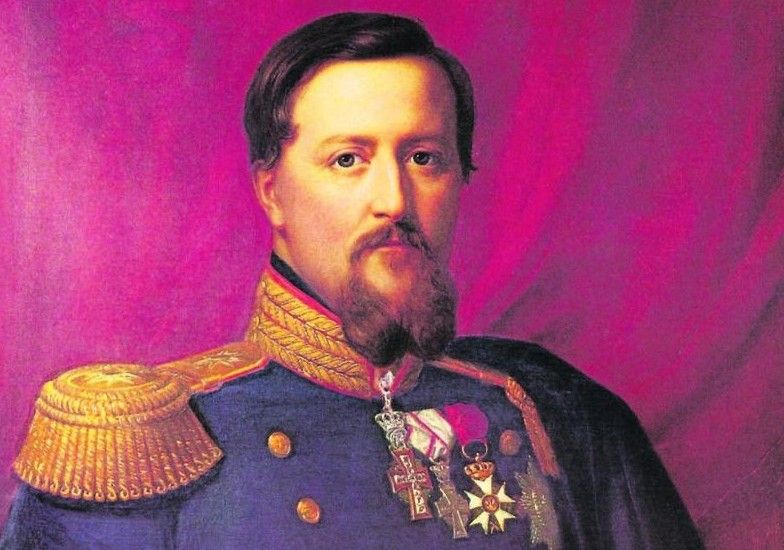
1848
Kongen erklærer sig som konstitutionel
I marts 1848 krævede borgerskabet i København, at kong Frederik 7. skulle indføre en fri forfatning. Presset af den ophidsede folkestemning erklærede kongen sig som konstitutionel konge og ophævede den enevældige statsform.
-

1848
Den grundlovsgivende Rigsforsamling
I 1848 blev der sammensat en grundlovgivende Rigsforsamling for at udarbejde Danmarks Riges Grundlov.
-

1848
Afslag fører til borgerkrig
I 1848 fik Slesvig og Holsten afslag på deres krav om en selvstændig fri forfatning for Slesvig og Holsten. Afslaget førte til borgerkrig mellem slesvigske og holstenske oprørere på den ene side og Danmark på den anden side.
-
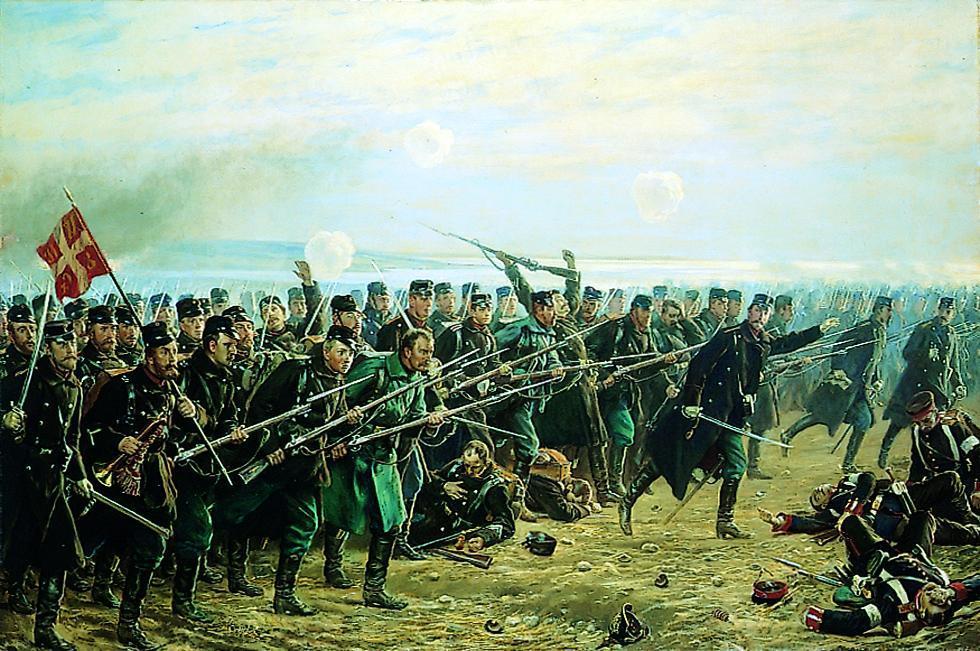
1848-1850
Den 1. Slesvigske Krig (Treårskrigen)
I 1848 fik Slesvig og Holsten afslag på deres krav om en selvstændig fri forfatning for Slesvig og Holsten. Afslaget førte til borgerkrig mellem slesvigske og holstenske oprørere på den ene side og Danmark på den anden side. Mellem 1848 og 1850 fandt der en borgerkrig sted mellem kongeriget Danmark og tysksindede oprørere i hertugdømmerne Slesvig og Holsten. Denne krig var resultatet af stigende nationalbevidsthed og spændinger mellem danske og tyske identiteter i det danske rige. Krigen endte med dansk sejr, men konflikten blev ikke fuldstændigt løst. Treårskrigen i perioden 1848-50 kaldes også Den 1. Slesvigske Krig, og den inkluderede afgørende slag som dem ved Fredericia og Isted.
-

5 Juni 1849
Danmarks første demokratiske grundlov
Den 5. juni 1849 underskrev Frederik 7. Danmarks første frie forfatning, Danmarks Riges Grundlov. Med grundloven fik Danmark et parlament med to lovgivende forsamlinger, Folketinget og Landstinget, der samlet blev kaldt Rigsdagen. N.F.S. Grundtvig spillede en vigtig rolle i Den grundlovsgivende Rigsforsamling, der udformede Danmarks første demokratiske grundlov, som trådte i kraft 5. juni 1849. Hans indsats sikrede, at den danske kirke ikke blev en statskirke men forblev en folkekirke, hvilket afspejler hans tanker om folkelighed. På dette tidspunkt fandtes der ikke politiske partier, som de kendes i dag. Grundloven krævede, at et medlem af Rigsdagen skulle tjene hele folket uden at være bundet af særinteresser. Over tid førte udviklingen af folkestyret til fremkomsten af politiske interessegrupper og partier. Grundlovens vedtagelse betød, at kongens magt blev delt med folkevalgte repræsentanter. Kongeloven fungerede som grundlag for enevældig magt i Danmark indtil den første demokratiske grundlov blev indført i 1849.
-
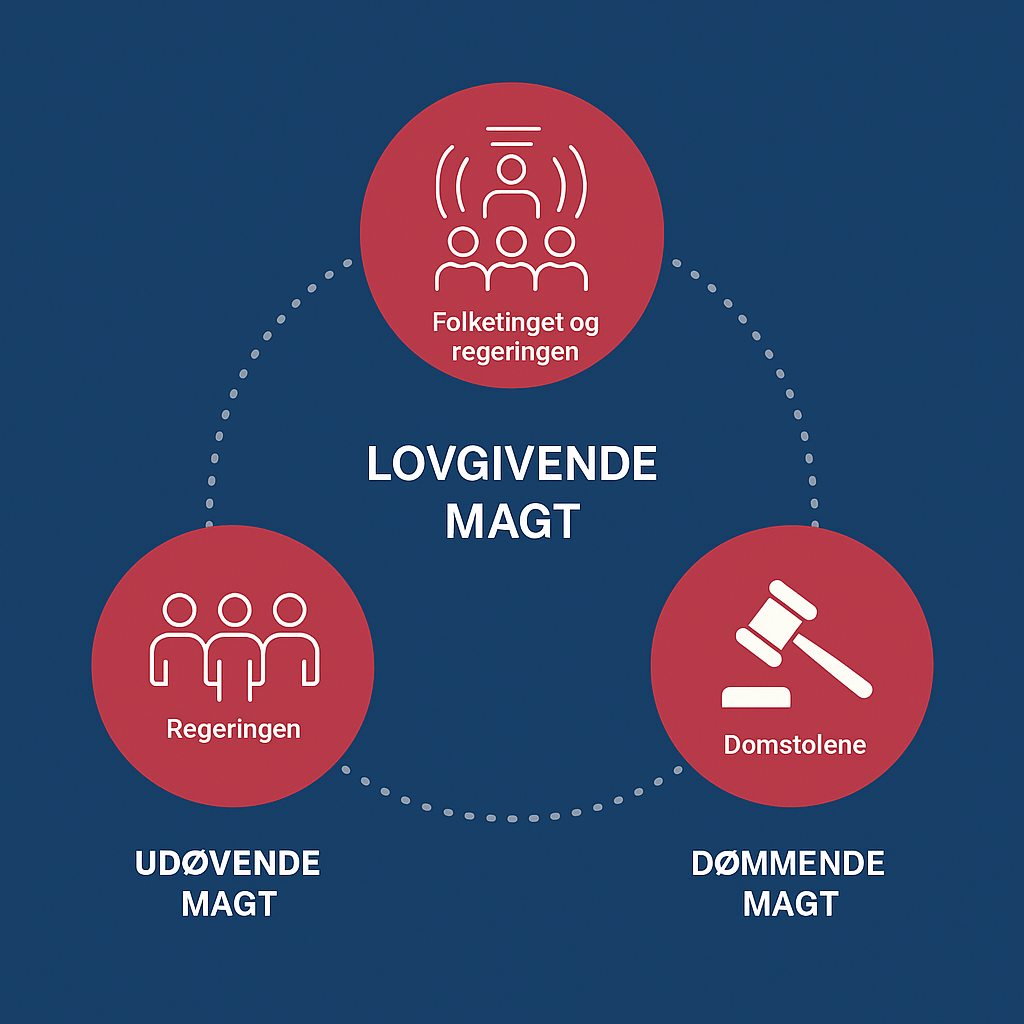
1849
Grundloven indfører tredeling af magten
Tredelingen af statens magt i lovgivende, udøvende og dømmende magt blev indført med grundloven i 1849, der ophævede kongens enevældige magt.
-

1849
Religionsfrihed indført i grundloven
Religionsfrihed blev indskrevet i den danske grundlov i 1849 som en af de grundlæggende frihedsrettigheder. Dette sikrede, at borgerne havde ret til at forene sig i trossamfund og dyrke deres tro på den måde, de ønskede.
-

1849
Indførelse af Rigsretten
Rigsretten blev indført med den første grundlov i 1849. Siden da har der kun været rejst seks rigsretssager mod ministre.
-

1849
Færøerne under grundloven
Færøerne kom under den danske grundlov i 1849, hvilket indebar flere rettigheder under det danske styre.
-

Juli 1849
Slag ved Fredericia
I 1849 udkæmpede Danmark og slesvig-holstenerne en række slag, herunder et ved Fredericia i juli, hvor den danske hær sejrede.
1850s
-

1850
Drivhuseffekten opdaget
For over 100 år siden blev drivhuseffekten opdaget. Dengang troede man, det ville tage tusinder af år før det blev et problem, men det kom til at gå meget hurtigere.
-
1850
Rusland presser Tyske Forbund
I 1850 blev Det Tyske Forbund og Preussen presset af Rusland til at trække deres hjælpetropper ud af konflikten, hvilket førte til en række danske sejre, blandt andet ved Isted i juli 1850.
-

Juli 1850
Slaget ved Isted
Slaget ved Isted i juli 1850 var det blodigste slag under krigen med tusindvis af døde og sårede, hvilket resulterede i, at de to hertugdømmer fortsat skulle indgå i den danske helstat.
-
1851
Mathilde Fibigers debutroman
Forfatteren Mathilde Fibiger udgav romanen 'Clara Raphael. Tolv Breve' i 1851, der satte gang i debatten om kvinders frigørelse og inspirerede kvindebevægelsen i Danmark.
-
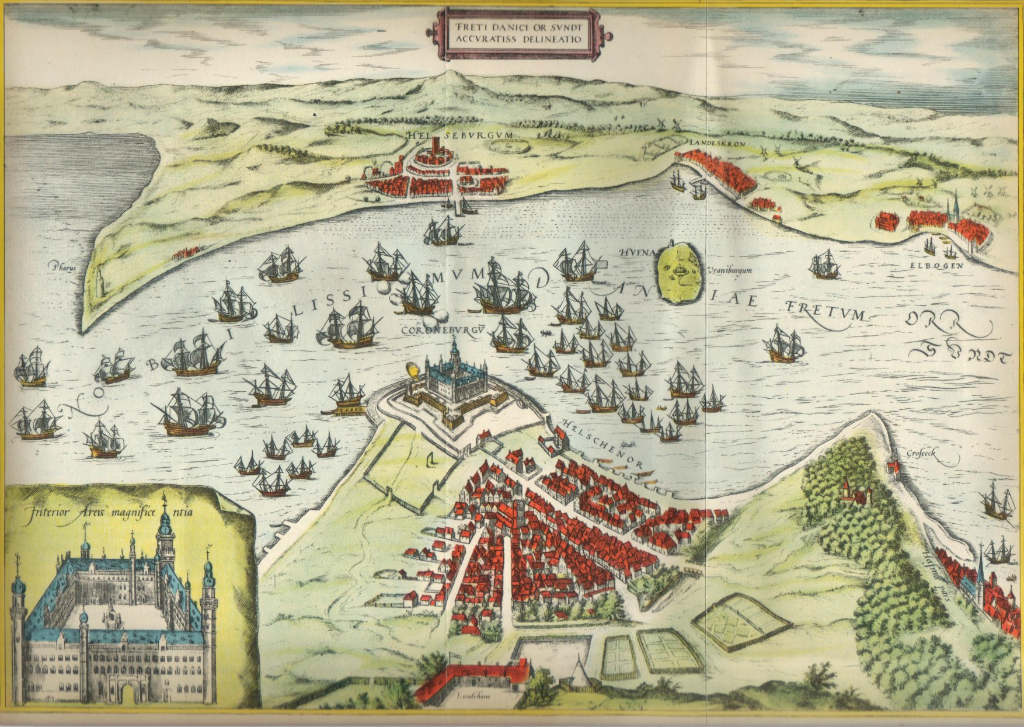
1857
Ophævelse af Øresundstold
Øresundstolden, en vigtig indtægtskilde for den danske konge og stat, blev ophævet i 1857.
-
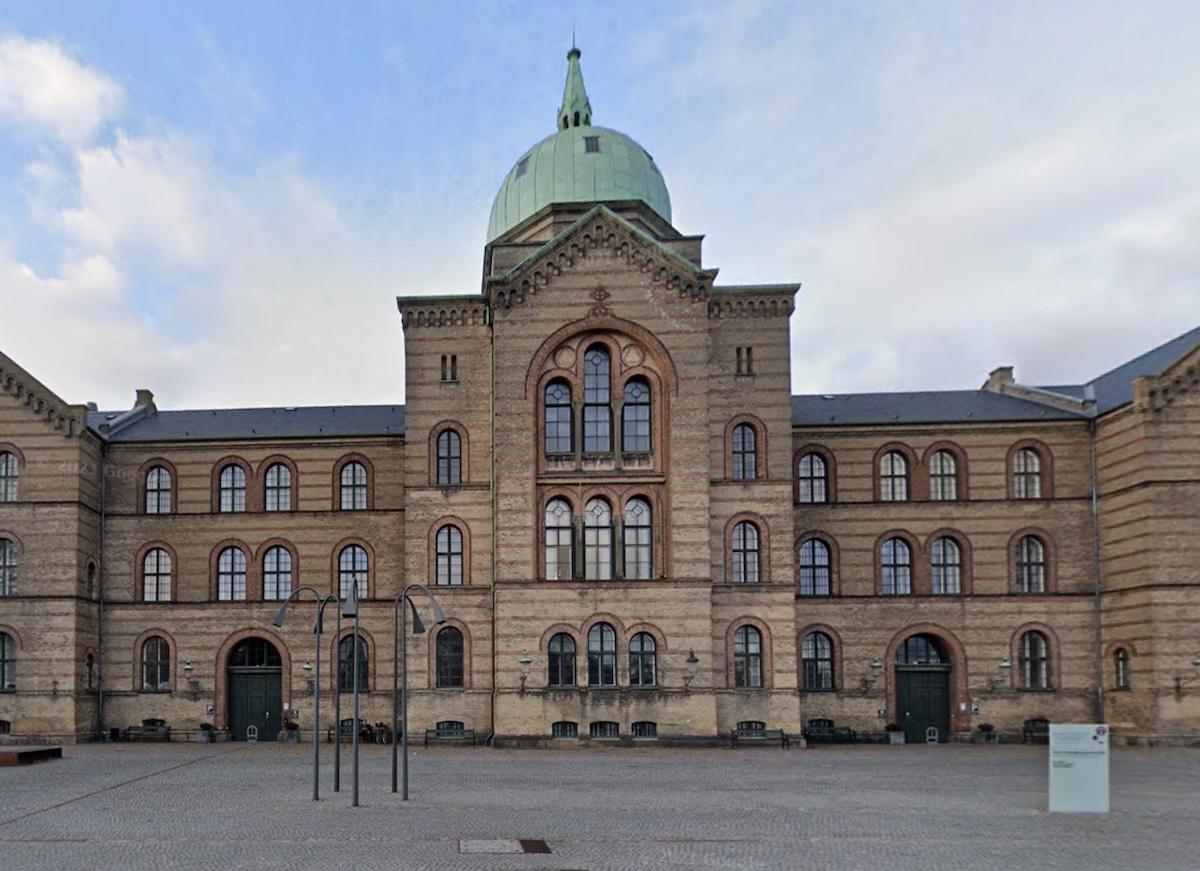
1858-1863
Københavns Kommunehospital opføres
Københavns Kommunehospital blev bygget mellem 1858 og 1863 og var et af Danmarks første moderne sygehuse. Dette hospital repræsenterede en væsentlig udvikling i det danske sundhedsvæsen og i opbygningen af sundhedspleje for borgere.
1860'erne
-
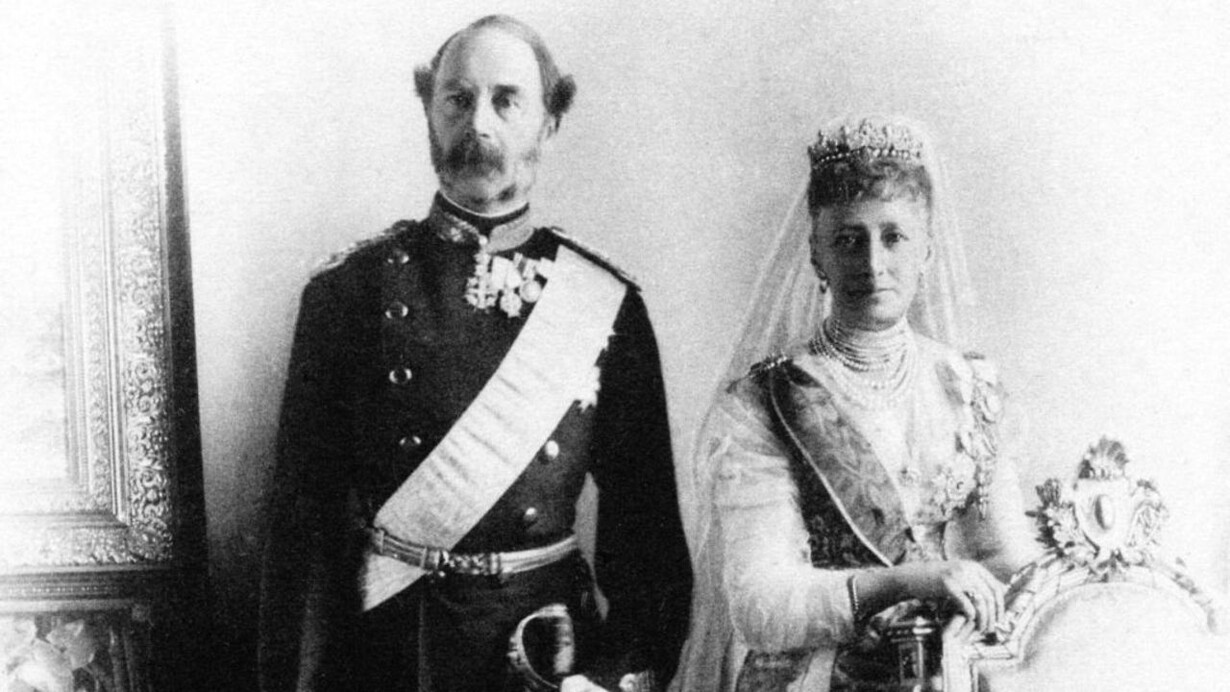
1863
Glücksborg-slægten overtager tronen
I 1863 overtog Glücksborg-slægten den danske trone fra Oldenborg-slægten.
-
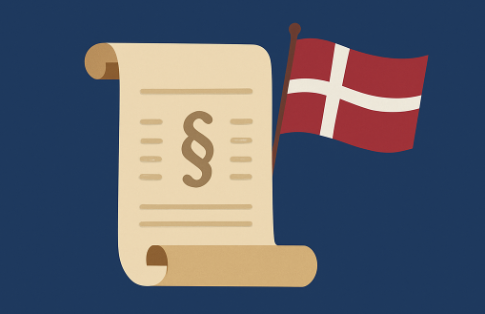
1863
Danmark vedtager ny forfatning
I 1863 vedtog den danske rigsdag presset af folkestemningen en ny fælles forfatning for både Danmark og Slesvig, men ikke for Holsten. De tyske stater opfattede denne forfatning som et brud på en tidligere aftale.
-
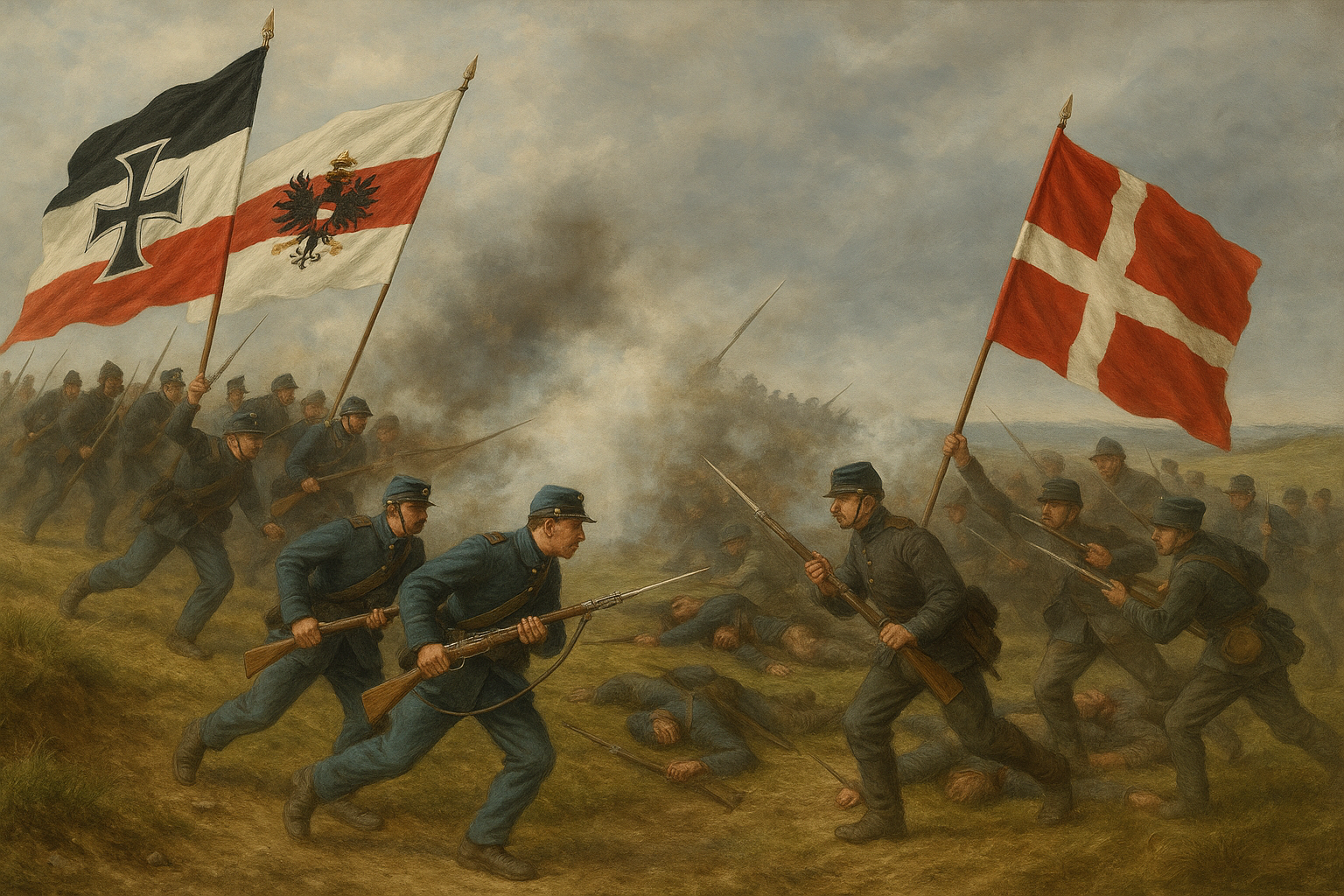
februar 1864
Den 2. Slesvigske Krig starter
I februar 1864 erklærede Preussen og Østrig krig mod Danmark, kendt som Den 2. Slesvigske Krig. Krigen startede, efter at Danmark havde vedtaget en ny forfatning for Danmark og Slesvig.
-
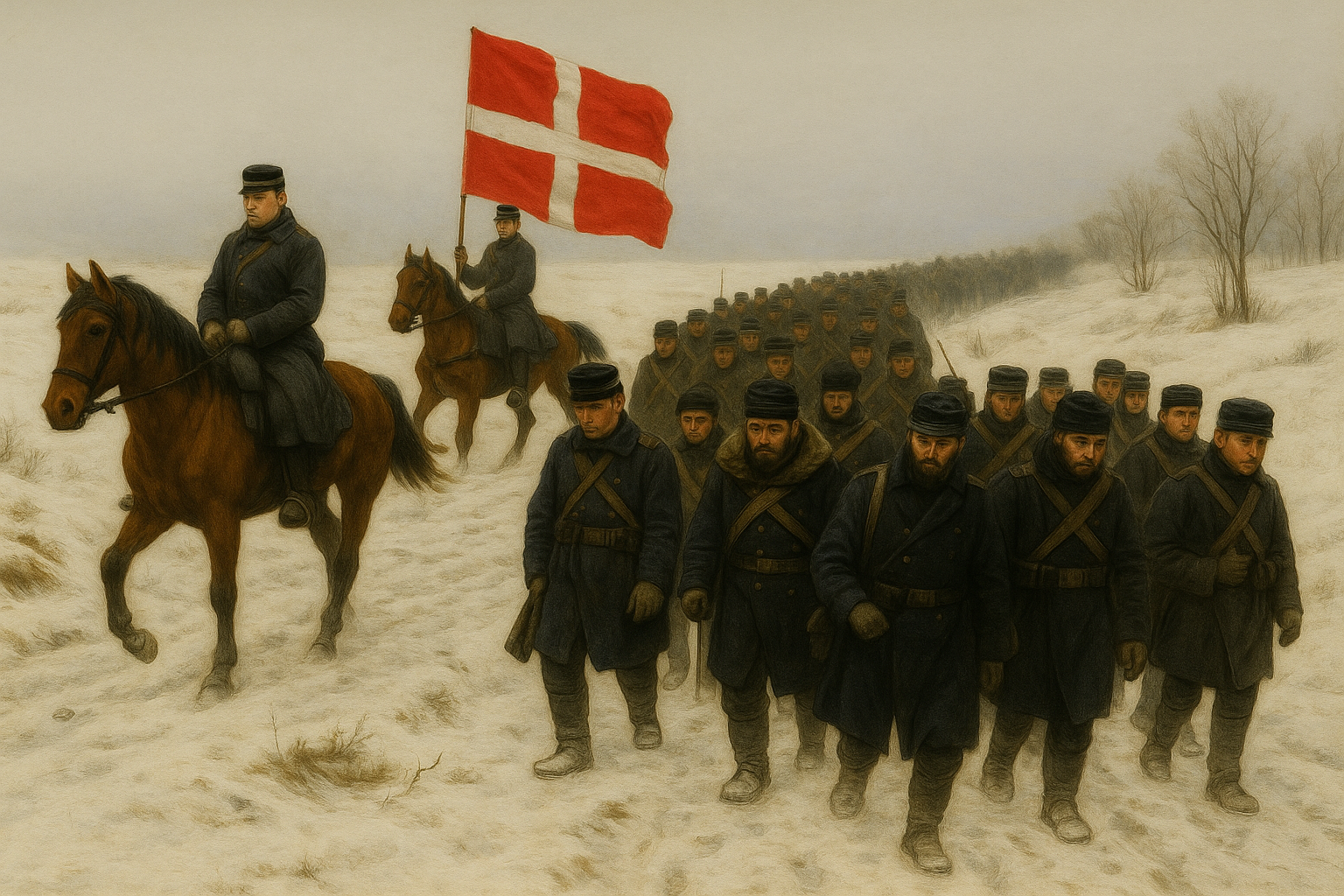
februar 1864
Dansk tilbagetrækning fra Dannevirke
I februar 1864 måtte den danske hær evakueres i al hast fra Dannevirke, et gammelt forsvarsanlæg, da de fjendtlige styrker var i overtal.
-
18. april 1864
Nederlag ved Dybbøl
Den 18. april 1864 angreb preusserne Dybbøl efter et langvarigt bombardement, og de danske styrker led nederlag. Dette var en del af Den 2. Slesvigske Krig.
-
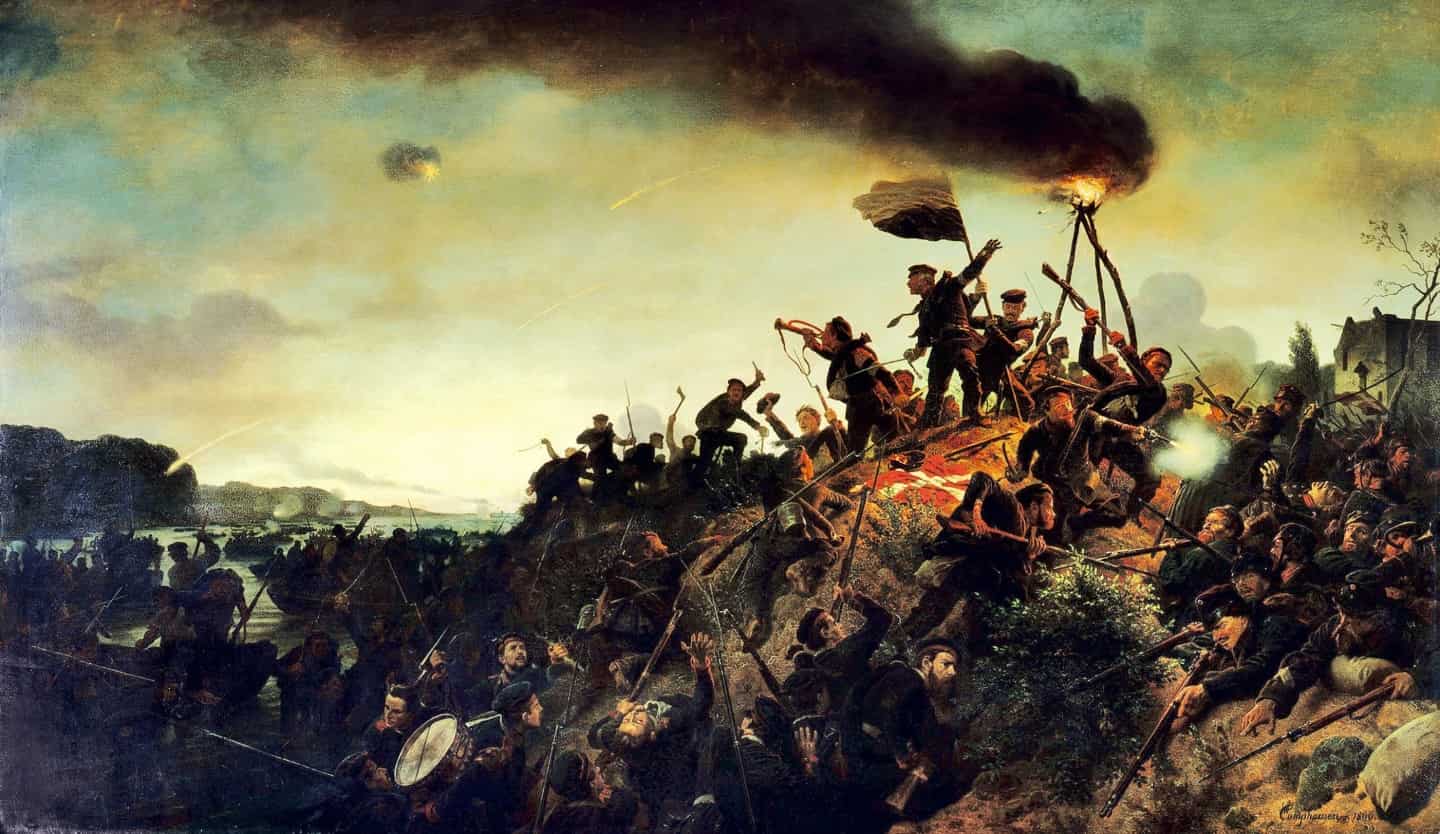
juni 1864
Jylland og Als besat
I slutningen af juni 1864 blev Jylland og øen Als besat af preussiske styrker, hvilket førte til, at Danmark indså, at krigen var tabt.
-

1864
Tabet af Slesvig og Holsten
Efter nederlaget i 1864 måtte Danmark afstå Slesvig, Holsten og Lauenborg til Preussen og Østrig, hvilket var en stor katastrofe for landet. Denne begivenhed, kendt som den 2. Slesvigske Krig, opstod som følge af fortsatte nationale spændinger mellem Danmark og tyske styrker, hvilket resulterede i en tysk sejr og Danmarks tab af hertugdømmerne Slesvig og Holsten.
Dette nederlag cementerede Danmarks status som en småstat og førte til, at dansk-sindede slesvigere syd for den nuværende grænse blev tyske statsborgere. Mange af disse deltog senere i tysk krigstjeneste under 1. Verdenskrig. Trods tabet styrkede denne periode den nationale sammenhængskraft og havde en stor påvirkning på Grundtvigs ideer om national identitet.
-
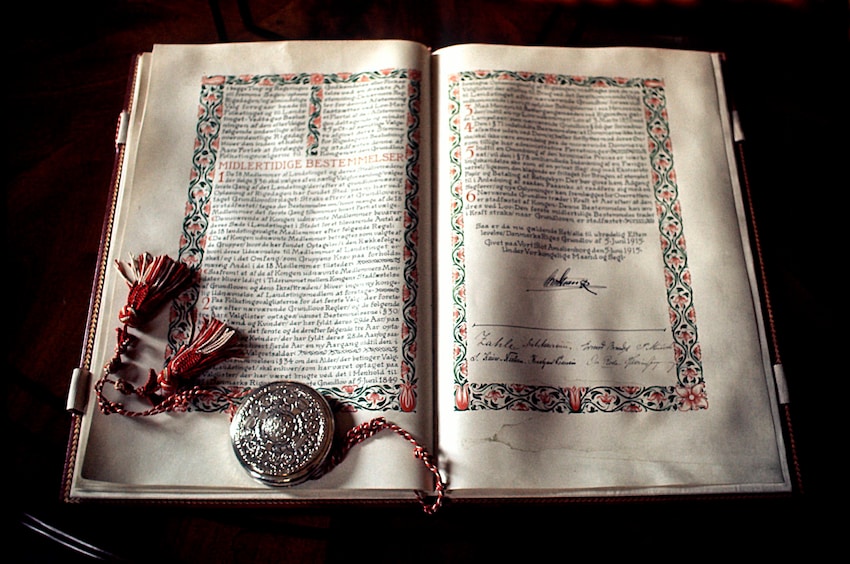
1866
Grundlovsændring 1866
I 1866 blev grundloven ændret, hvilket indebar et demokratisk tilbageskridt. Kongen og de med de højeste indtægter fik ret til at vælge det meste af Landstinget, mens bredere stemmeret blev fastholdt i Folketinget. Denne ændring var en af de få, der er blevet foretaget siden grundlovens første udgivelse.
-

1868
Udvandring af danskere til USA
Særligt i årene 1868-1914 udvandrede over 300.000 danskere til USA. Dette skete af forskellige årsager, herunder økonomiske muligheder og sociale forhold.
1870'erne
-
1870
Forfatningskampen og partistiftelse
I 1870-erne blev den politiske strid mellem højre- og venstrekræfter i Rigsdagen intensiveret, hvilket førte til stiftelsen af de politiske partier Højre og Venstre.
-

1870
Industrialiseringen i Danmark begynder
Fra 1870’erne voksede industri og håndværk hurtigt i Danmark, hvilket førte til urbanisering, hvor befolkningen flyttede fra land til byer, der voksede i størrelse. Landbrugsvarer udgjorde stadig en stor del af Danmarks eksport, men der skete en fremgang i animalsk produktion gennem andelsforeningers mejerier og slagterier.
-

1870
Skift i dansk landbrugsproduktion
Fra midten af 1870'erne skiftede danske landmænd fra korn til animalsk produktion på grund af faldende kornpriser. Denne omlægning blev muliggjort af dampskibes og jernbaners ankomst, der gjorde import af billigt korn fra USA og Østeuropa mulig.
-

1871
Bismarck danner Tysk Kejserrige
I 1871 samlede Bismarck de tyske stater i et stærkt kejserrige, hvilket gjorde Danmark til en småstat uden betydelig indflydelse i Europa.
-

1871
Dansk Kvindesamfund stiftes
Foreningen Dansk Kvindesamfund – Danmarks ældste kvindeorganisation – blev stiftet i 1871. Den var afgørende for, at der frem mod 1920’erne skete en række store fremskridt i kvinders rettigheder.
-
1871
Grundlæggelse af Den internationale Arbejderforening
I oktober 1871 blev 'Den internationale Arbejderforening for Danmark' grundlagt som en del af den internationale socialistiske bevægelse, der opfordrede til strejker og demonstrationer for bedre vilkår og højere løn til arbejderne. -
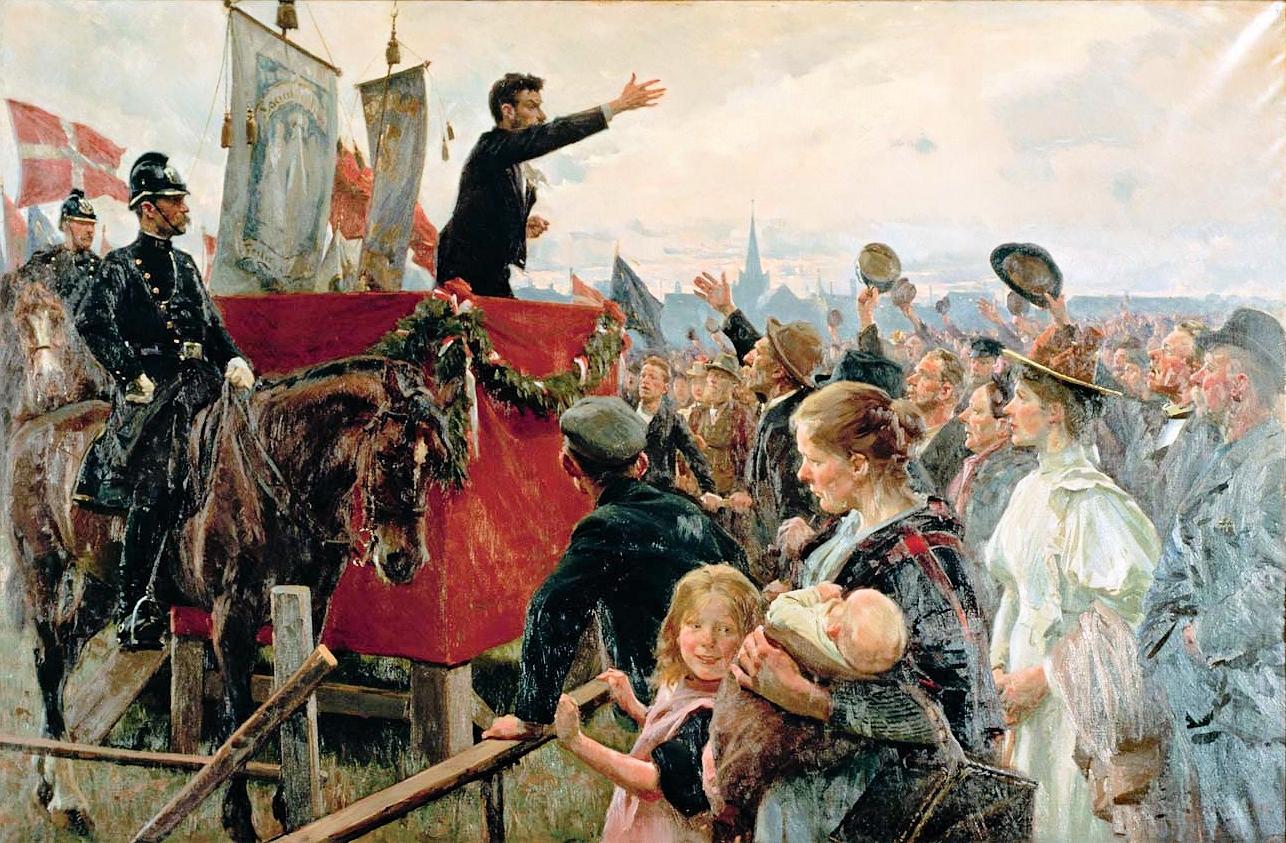
1872
Slaget på Fælleden
Slaget på Fælleden fandt sted i maj 1872 og var et sammenstød mellem demonstrerende arbejdere og myndighederne i København, der endte i kampe mellem politi og soldater på den ene side og arbejdere på den anden.
-
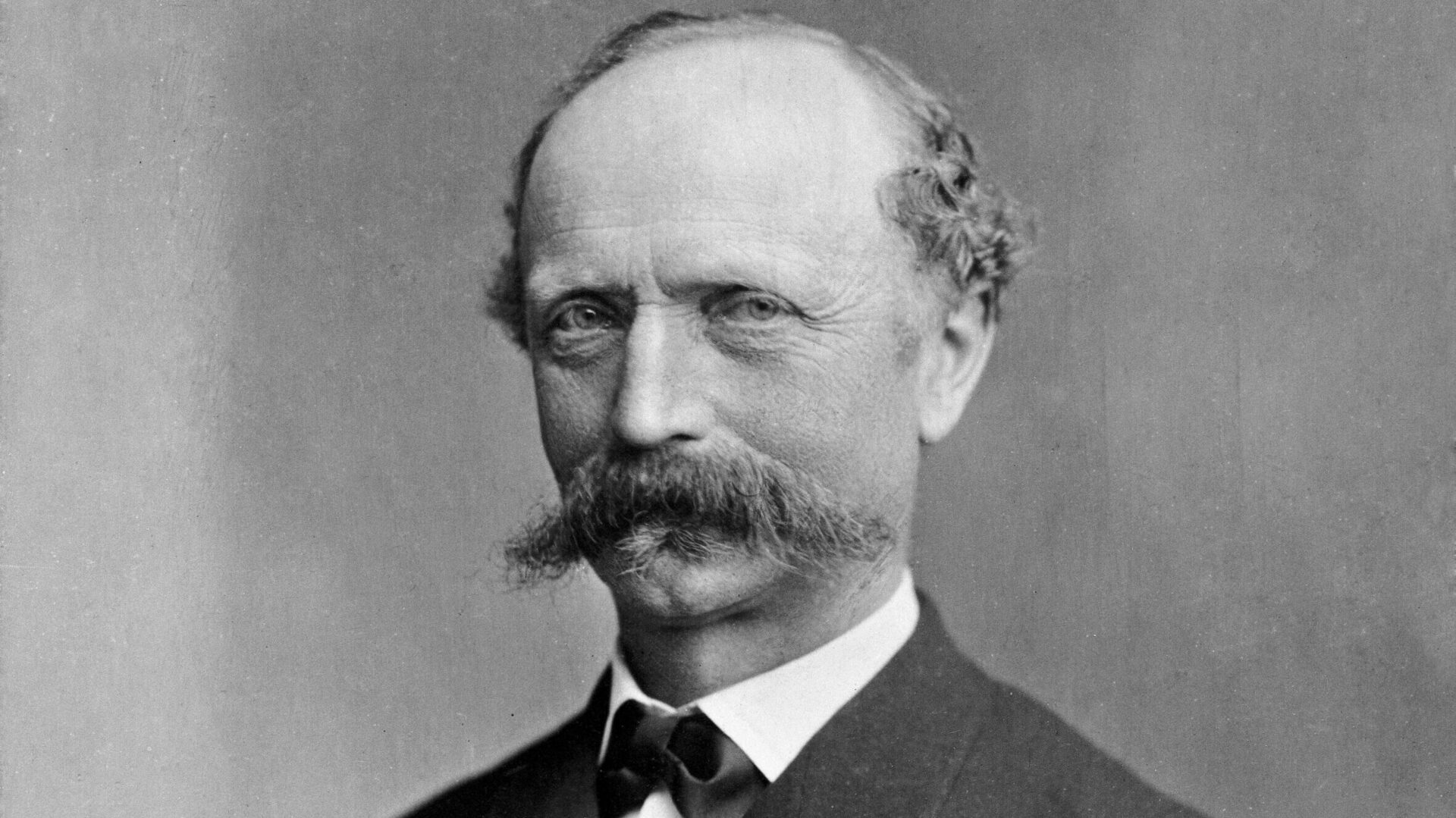
1875
Estrup som regeringsleder
Godsejer J.B.S. Estrup fra partiet Højre blev Danmarks konseilspræsident, regeringsleder, i 1875 og ledede regeringen med kongens opbakning, selvom han var i mindretal i Folketinget.
-

1875
Kvinder får adgang til uddannelse
I 1875 fik kvinder adgang til at få en studentereksamen og til at komme på universitetet. Studentereksamen skulle dog tages ved private pigeskoler frem til 1903, hvor de offentlige gymnasier også blev åbnet for piger.
-
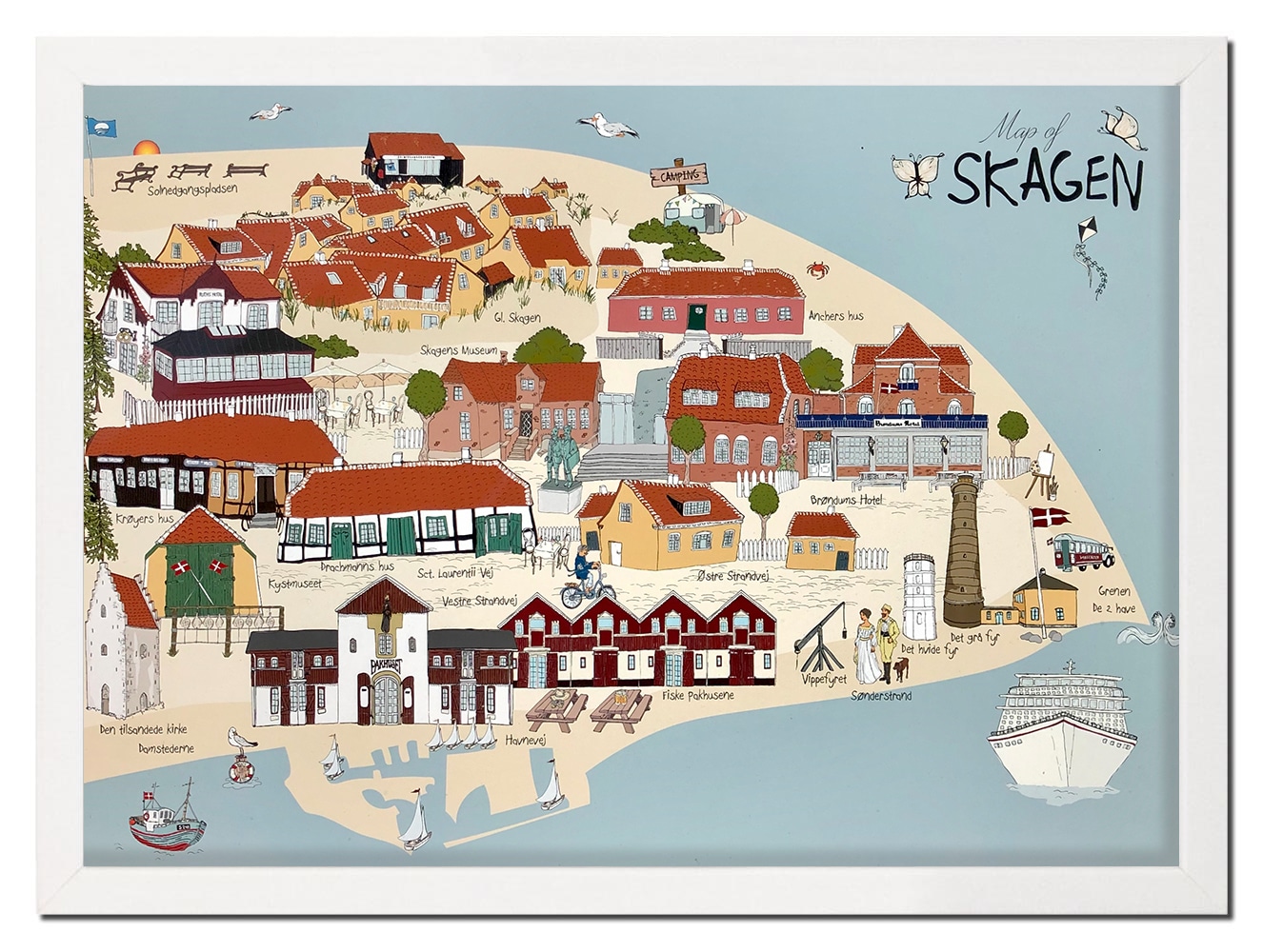
1875-1910
Skagen som mødested for malere
I perioden cirka 1875-1910 blev Skagen om sommeren et internationalt mødested for malere som Anna Ancher, Michael Ancher og P.S. Krøyer, der søgte nye motiver blandt fiskerne og det særlige lys.
-
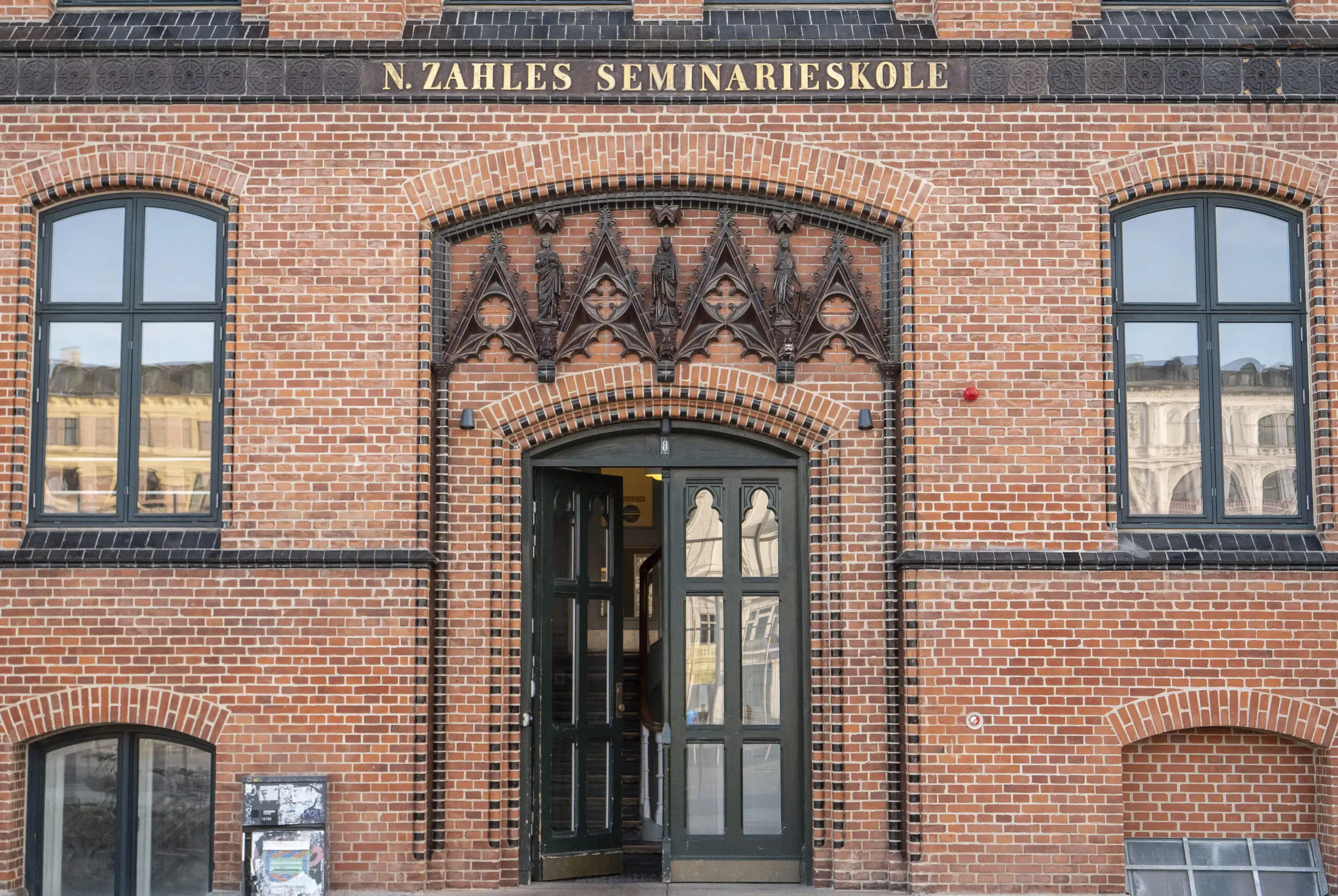
1877
Grundlæggelse af N. Zahles Skole
Nathalie Zahle, en forkæmper for kvinders ret til uddannelse og selvstændighed, grundlagde 'N. Zahles Skole' i København i 1877.
-

1878
Socialdemokratiet bliver selvstændigt parti
Socialdemokratiet, der oprindeligt var en del af arbejderbevægelsen, blev et selvstændigt parti i 1878.
1880'erne
-

1880
Gifte kvinder får ejerskab over løn
I 1880 fik gifte kvinder ret til at hæve og bruge deres egen løn, hvilket markerede et vigtigt skridt mod økonomisk uafhængighed for kvinder.
-
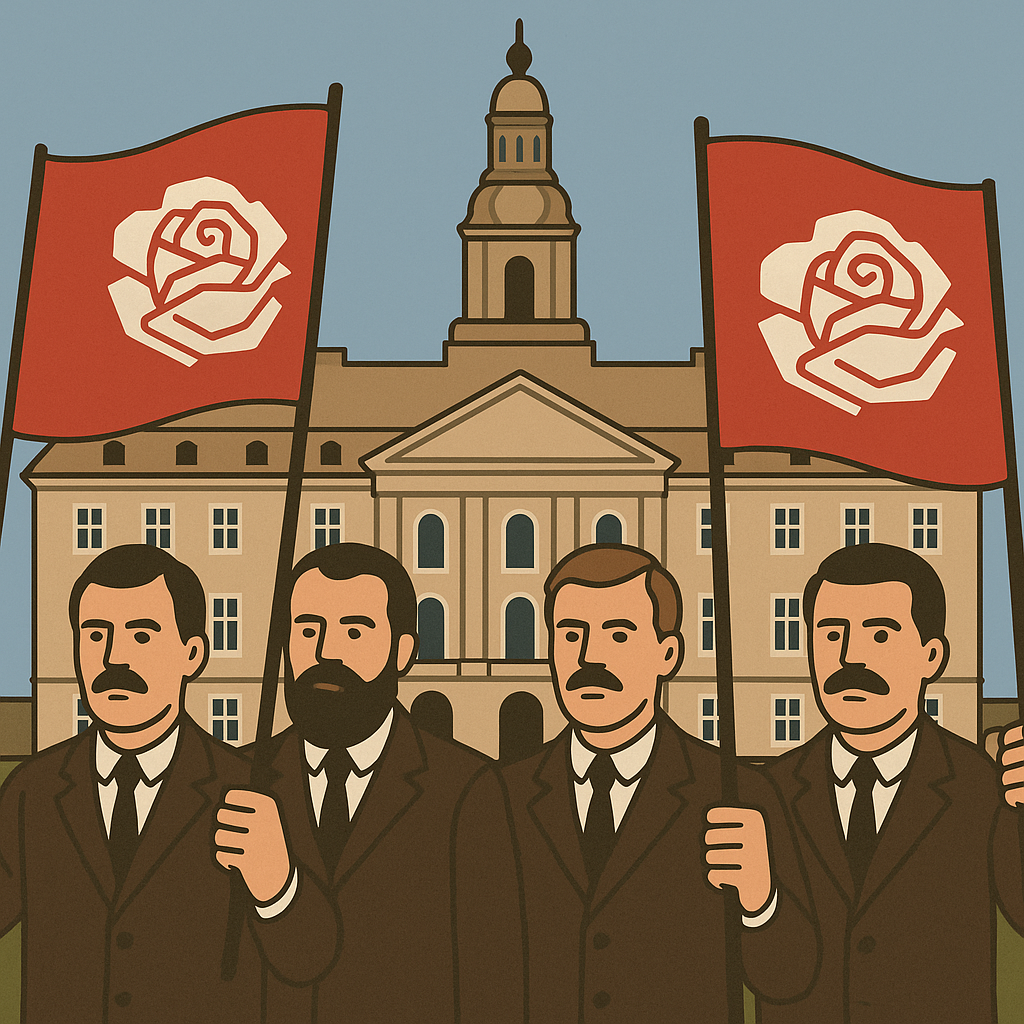
1884
Første socialdemokrater i Folketinget
I 1884 blev de to første socialdemokrater valgt ind i Folketinget, markerende en politisk milepæl for arbejderbevægelsen.
1890'erne
-
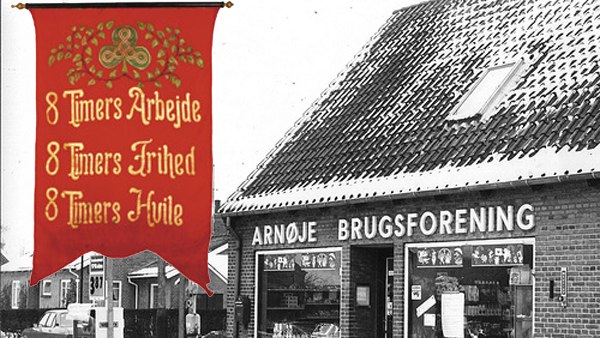
1890
Starten af andelsbevægelsen
Den kooperative bevægelse, også kendt som 'The Co-operative Movement', opstod i England i 1840'erne. Denne bevægelse nåede Danmark senere og førte til dannelsen af den danske andelsbevægelse, hvor bønderne samarbejdede om produktion og indkøb.
-
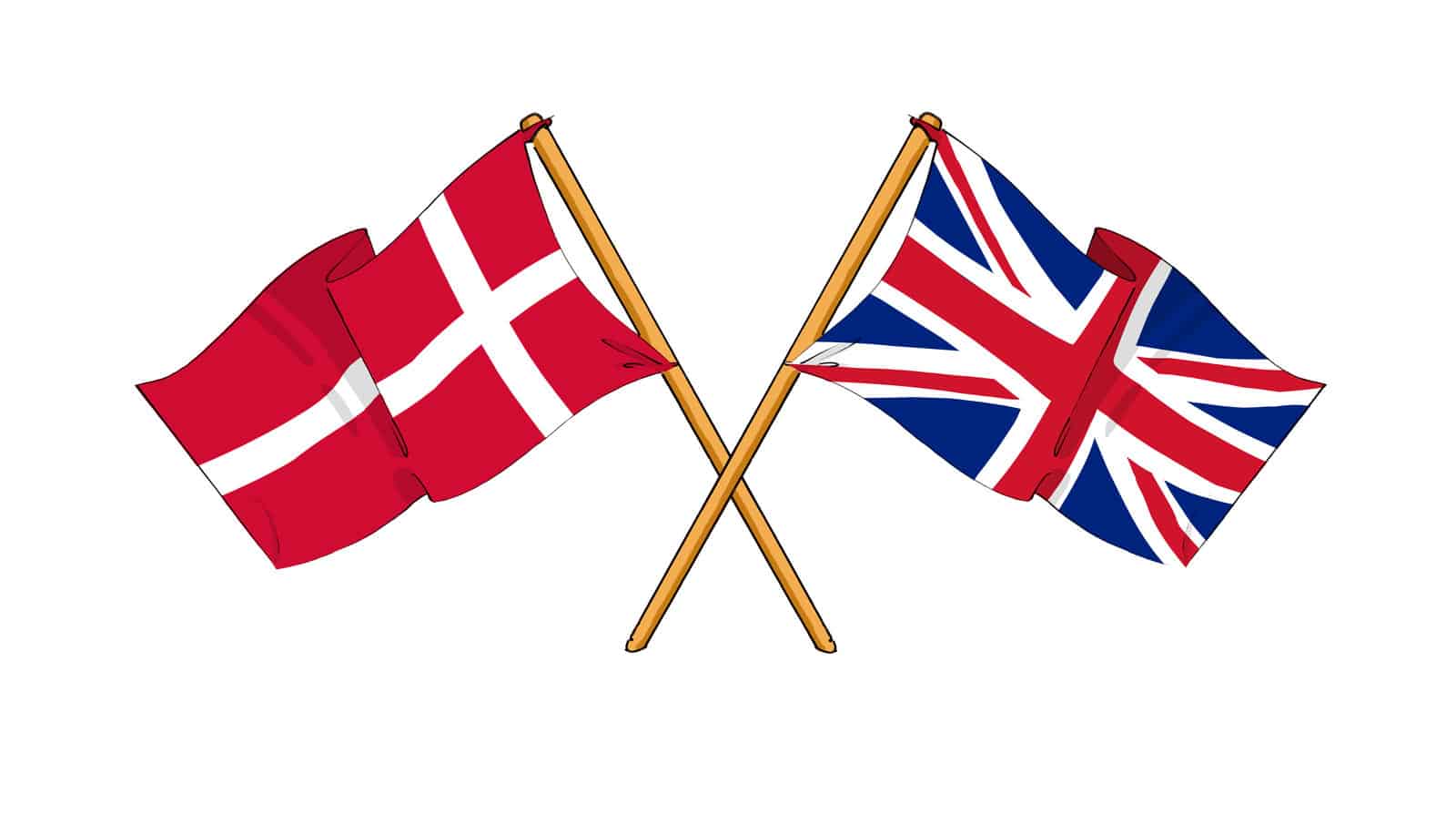
1890-1914
Danmarks eksportboom til Storbritannien
I perioden fra 1890 til 1914 blev produkter fra den danske animalske produktion, som smør og bacon, Danmarks største eksportvarer. Over halvdelen af denne eksport blev aftaget af Storbritannien, hvilket var en betydelig faktor for økonomiens vækst.
-

1890
Starten på velfærdssamfundet i Danmark
De første skridt mod det moderne velfærdssamfund blev taget i 1890'erne, i en tid med store økonomiske og sociale forandringer. Landbruget blev omlagt, industrien voksede, og byerne blev større. Ændringerne medførte, at private sociale ordninger forsvandt, og staten begyndte i stigende grad at yde hjælp til borgere i nød.
-
1892
Sidste henrettelse i fredstid
Den sidste henrettelse for en forbrydelse, der blev begået i fredstid, fandt sted i 1892.
-

1893
Indførelse af statslige tilskud til sygekasser
Fra 1893 begyndte staten at give tilskud til sygekasser, hvilket var forsikringsordninger i forhold til sygdom. Dette gjorde det muligt for mennesker, som betalte et fast bidrag, at få dækket udgifterne ved lægebesøg og andre sundhedsydelser.
-
1894
Udgivelse af første Højskolesangbog
Siden 1894 er Højskolesangbogen udkommet i mange udgaver. Den indeholder talrige fædrelandssange og salmer, hvoraf flere er skrevet af Grundtvig.
-

1899
Indgåelsen af Septemberforliget
Septemberforliget blev indgået i 1899 mellem fagforeninger og arbejdsgiverorganisationer. Det anerkendte fagforeninger og arbejdsgiverorganisationer som berettigede til at forhandle på deres medlemmers vegne.
Aftalen, kendt som 'Arbejdsmarkedets Grundlov', fastlægger løn- og arbejdsvilkår og indfører fredspligt. Forliget blev en grundsten i den danske arbejdsmarkedsmodel. I september 1899 endte en langvarig strid mellem arbejdsgivere og arbejdere med en historisk aftale, Septemberforliget, som stadig ligger til grund for den måde, man laver aftaler på det danske arbejdsmarked.
1900s
-

1900
De første film optaget i Danmark
Omkring år 1900 blev de første film optaget i Danmark. Det var reportager om samfundet.
-
1900
Fald i højskolebevægelsens betydning
Højskolebevægelsens betydning blev mindre i takt med industrialiseringen i løbet af 1900-tallet, hvor landbruget mistede betydning, og vandringen fra land til by tog fart. -

1900
Vilhelm Hammershøis maleri 'Interiør fra Strandgade 30'
Vilhelm Hammershøis maleri 'Interiør fra Strandgade 30', fra 1900, skildrer lys og skygge i hjemmets rum og blev i 2023 solgt for 62,8 millioner danske kroner.
-
1900
Modernisering af Danmark
Slutningen af 1800-tallet og begyndelsen af 1900-tallet var præget af en omfattende modernisering af det danske samfund, med industriel udvikling, stigende velstand og politiske reformer for en friere økonomi. -
1900
Udviklingen af velfærdsstaten
I anden halvdel af 1900-tallet udviklede velfærdsstaten sig for alvor i Danmark. Det blev vigtigt at styrke kulturlivet, videnskaben og kunsten, da et aktivt kulturliv blev betragtet som en forudsætning for det enkelte menneskes trivsel og velbefindende. Kunsten blev set som demokratiske grundlag, og det blev anerkendt, at kunst kunne provokere og stille spørgsmål ved vedtagne sandheder. -
1901
Systemskiftet, parlamentarismens indførelse og statsministerposter frem til 2023
Først med Systemskiftet i 1901 måtte kongen acceptere, at Folketinget bestemmer, hvem der skal have regeringsmagten; dette system kaldes parlamentarisme. Systemskiftet brød den politiske fastlåsthed og indførte det parlamentariske princip i Danmark, hvor en regering ikke kan have et flertal imod sig i Folketinget. Siden systemskiftet i 1901 og frem til 2023 har Socialdemokratiet haft statsministerposten i 61 år, Venstre i 37 år, Radikale Venstre i 12 år, og Det Konservative Folkeparti i 10 år.
-

1903
Indførelse af permanent indkomstskat
I 1903 blev indkomstskatten indført som permanent skat i Danmark. Dette skete med en markant lavere skatteprocent end i moderne tider, og det medførte, at næsten alle indkomster blev skattepligtige uanset deres oprindelse.
-
1903
Offentlige gymnasier åbner for piger
Fra 1903 kunne piger også tage en studentereksamen ved offentlige gymnasier, en ændring fra tidligere, hvor det kun var muligt på private pigeskoler. -

1905
Dannelsen af Det Radikale Venstre
I 1905 blev Det Radikale Venstre dannet af udbrydere fra Venstre, med primært akademikere og husmænd som sympatisører.
-

1906
Grundlæggelsen af Nordisk Film
I 1906 blev Nordisk Film grundlagt, hvilket førte til en hurtigt voksende dansk filmindustri, kendt i mange lande.
1910s
-
1910
Beslutning om international kvindedag
På en international, socialistisk kvindekonference i 1910 i 'Folkets Hus' på Jagtvej i København, blev det besluttet at indføre en international kampdag for kvinder. -

1910
Oprettelse af Forligsinstitutionen
Siden 1910 har staten haft Forligsinstitutionen, også kendt som 'forligsmanden', til at afværge konflikter på arbejdsmarkedet. Forligsmanden kan indkalde til forhandlinger eller fremsætte mæglingsforslag og udskyde truende konflikter.
-
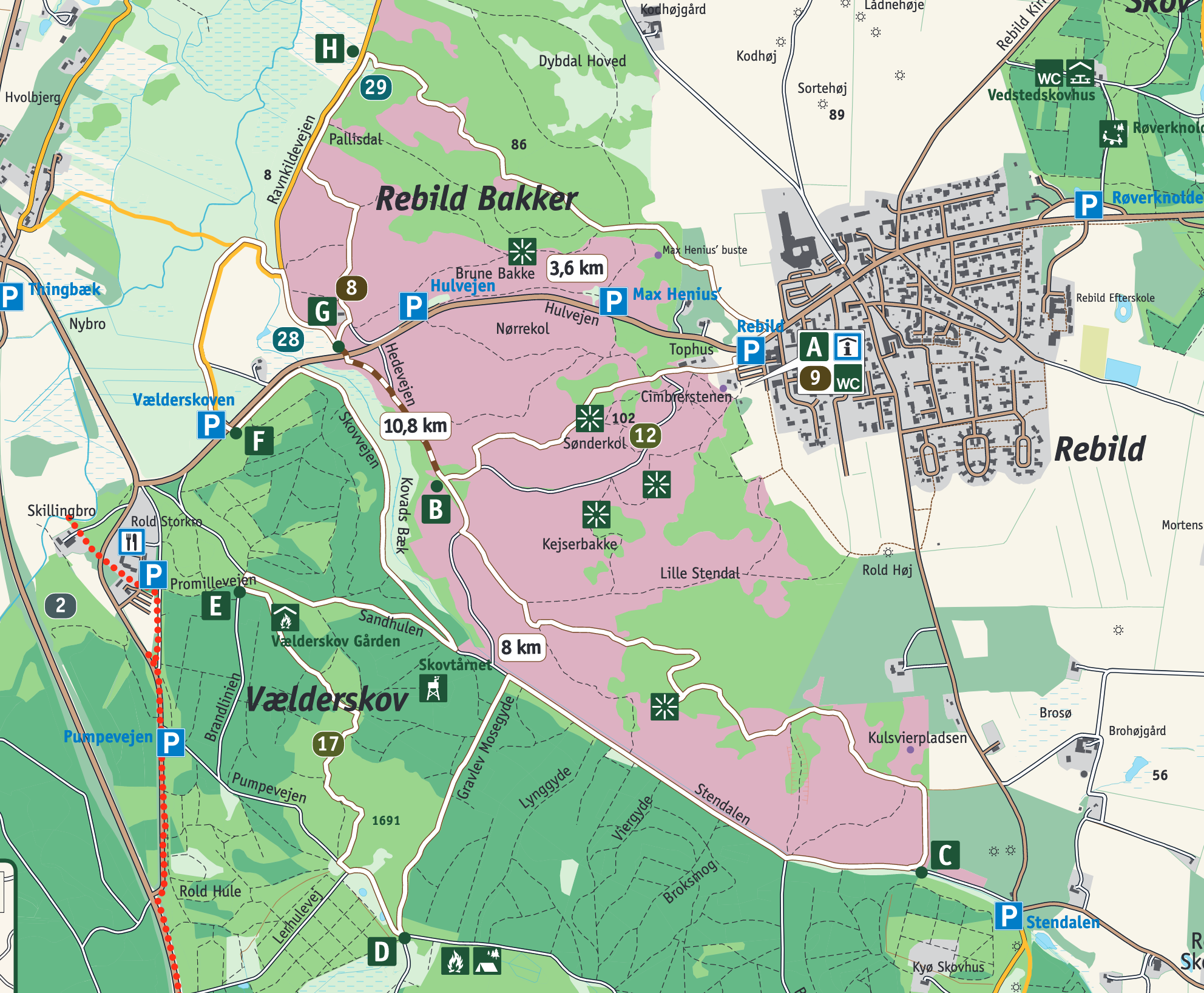
1912
Dansk-amerikanere køber del af Rebild Bakker
I 1912 blev en del af Rebild Bakker købt af dansk-amerikanere. Området bruges blandt andet til en årlig dansk-amerikansk fejring af USA's uafhængighedsdag den 4. juli.
-

1912
Starten af Thule-ekspeditionerne
Knud Rasmussen begyndte sine såkaldte Thule‑ekspeditioner i 1912. Mellem 1912 og 1933 gennemførte han syv ekspeditioner, som kortlagde Grønlands og andre arktiske områders geografi og indsamlede omfattende viden om inuitterne.
-

1913
Skulptur af Den lille Havfrue
Den berømte skulptur af 'Den lille Havfrue' blev skabt i 1913 og placeres på en sten i Københavns Havn. Den er 125 cm høj og er en af Danmarks mest kendte turistattraktioner.
-

1914
Gamle trærutsjebane
Den gamle trærutsjebane blev bygget i 1914 og er en af Tivolis mest kendte forlystelser.
-
1914
Kvinders lavere løn i 1914
I 1914 tjente mænd i industri og håndværk 55 øre pr. arbejdstime, mens kvinder kun tjente 30 øre. Kvindelige lærere fik frem til 1919 kun to tredjedele af mændenes løn. -

1914
Udbrud af 1. Verdenskrig
I 1914 brød 1. Verdenskrig ud, hvor de største europæiske magter som Tyskland, Østrig-Ungarn og Osmannerriget blev inddraget på den ene side, og Frankrig, Rusland, Storbritannien, Italien og senere også USA på den anden. Danmark forblev neutralt men blev presset af Tyskland til at lægge miner i danske farvande for at forhindre britiske skibe i Østersøen.
-
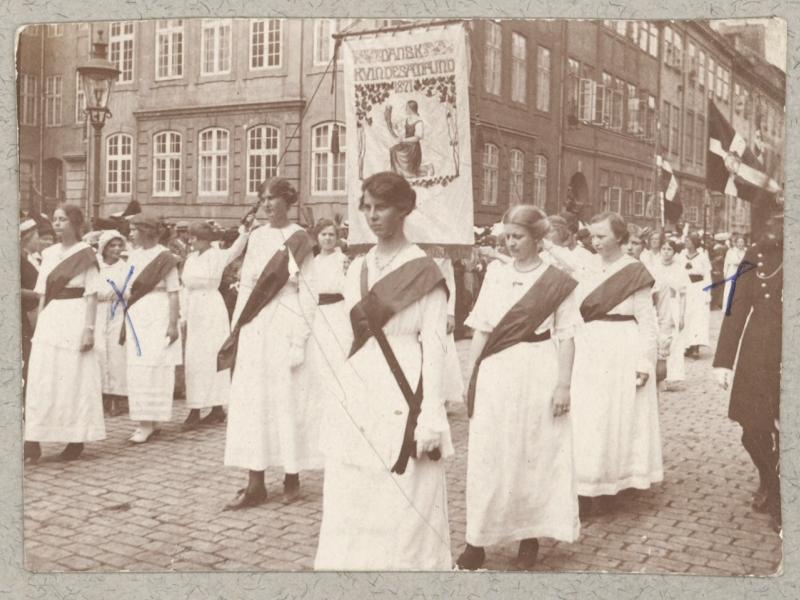
1915
Grundlovsændringen i 1915 giver kvinder valgret i Danmark
Med grundloven af 1915 fik danske kvinder og tjenestefolk valgret til Rigsdagens to kamre – Folketinget og Landstinget – med ikrafttræden i 1918. Dette gjorde Danmark til et af de første lande, som indførte kvinders parlamentariske valgret.
-

1915
Højres reorganisering
I 1915-16 reorganiserede det gamle godsejerparti Højre sig under navnet Det Konservative Folkeparti, søgte bredere vælgertilslutning og anerkendte nu det parlamentariske princip og lige valgret.
-
1915
USA tilbyder at købe Dansk Vestindien
I 1915 tilbød USA den danske regering at købe Sankt Thomas, Sankt Croix og Sankt Jan, da man frygtede tysk besættelse af øerne under 1. Verdenskrig. -
1917
Bolsjevikkerne tager magten i Rusland
I 1917 tog bolsjevikkerne magten i Rusland, som blev omdannet til Sovjetunionen. -
1917
Pontoppidan og Nobelprisen
Henrik Pontoppidan modtog Nobelprisen i litteratur i 1917 for sine romaner, herunder Lykke-Per. -
1917
Salg af Dansk Vestindien til USA
Efter en folkeafstemning i Danmark blev de Dansk Vestindiske Øer – Sankt Thomas, Sankt Croix og Sankt Jan (nu kendt som De Amerikanske Jomfruøer) – solgt til USA i 1917 for 25 millioner dollars. Samtidig anerkendte USA Danmarks suverænitet over Grønland. -
1918
Emma Gads Takt og Tone
Emma Gad udgav bogen 'Takt og Tone – Hvordan Vi Omgås' i 1918, en populær guide til god opførsel. -
1918
Forbundsloven giver Island selvstyre
I 1918 opnåede Island udstrakt selvstyre gennem Forbundsloven i en personalunion med Danmark. Den danske konge var også konge i Island, mens Danmark varetog Islands udenrigs- og forsvarspolitik. -
1918
Udbrud af Den Spanske Syge i 1918
I 1918 blev verden og Danmark ramt af en aggressiv, smitsom og dødbringende influenzavirus kaldet Den Spanske Syge. Sygdommen opstod ikke i Spanien, men navngivningen skyldes, at spanske aviser først rapporterede om den. Selvom Danmark ikke deltog i 1. verdenskrig, var landet ikke i stand til at bekæmpe sygdommen effektivt på grund af manglende viden og vaccinemuligheder. Sundhedsstyrelsen forsøgte at rådgive befolkningen om hygiejne og social distancering, og visse skoler og forlystelser blev lukket, men sygdommen spredte sig i bølger mellem 1918 og 1920. Den ramte primært unge voksne mellem 20 og 40 år. I alt døde omkring 15.000 mennesker i Danmark og op mod 50 millioner på verdensplan. -
1919
Merkið designet
Færøernes flag, kendt som 'Merkið', blev udarbejdet i 1919. Det er et flag af nordisk type med et kors og farverne hvidt, blåt og rødt.
1920s
-
1920
Funktionalismens opståen
Funktionalismen opstod i 1920’erne og spillede en vigtig rolle i at forbedre byernes boligstandard. Dens fokus på praktiske funktioner lever videre i mange aspekter af det danske velfærdssamfund. -
1920
Folkeafstemning i Nordslesvig
I februar 1920 stemte befolkningen i Nordslesvig for at genforenes med Danmark, hvilket førte til en ændring af grænsen mellem Danmark og Tyskland. -
1920
Genforeningen med Nordslesvig
I 1920 blev de dansksindede områder i den nordlige del af Slesvig genforenet med Danmark efter at have været en del af det tyske kejserrige. -
15. juni 1920
Grænsens ændring til Sønderjylland
Den 15. juni 1920 blev grænsen formelt flyttet sydpå fra Kongeåen, og Nordslesvig blev genforenet med Danmark under navnet Sønderjylland.
-
1920
Påskekrisen i Danmark
Påsken 1920 oplevede Danmark en forfatningskrise, da kong Christian 10. afskedigede regeringen på grund af uenighed om grænsepolitikken. Krisen resulterede i politiske protester og førte til dannelsen af en ny midlertidig regering. -
1920
Valgsystemets grundstruktur siden 1920
Siden valgsystemets grundstruktur blev til i 1920, har intet enkelt parti haft flertallet i Folketinget, hvilket har medført en tradition for samarbejde mellem partierne. -
1920
Ændring af grundloven i 1920
Grundloven blev ændret i 1920, en del af de historiske ændringer for at holde den opdateret. -
1921-1924
Femte Thule‑ekspedition (1921‑1924)
Knud Rasmussen ledte den femte og største Thule‑ekspedition fra 1921 til 1924. På en 18.000 km lang rejse med hundeslæde fra Thule i Grønland gennem det nordlige Canada og Alaska, over Beringstrædet til det østlige Sibirien, undersøgte han adskillige inuitbosættelser og dokumenterede en fælles kultur, sprog og tradition på tværs af hele det arktiske område. -
1921
Kvinder får lige adgang til offentlige stillinger
I 1921 fik kvinder lige adgang til de fleste offentlige stillinger, med undtagelse af forsvaret og præstestillinger. -
1921
Kvindernes internationale kampdag fastlagdes
Fra 1921 blev 8. marts fastlagt som den årlige dato for markeringen af kvindernes internationale kampdag, som nu fejres i mange lande verden over. -
1922
Fascismen vinder frem i Italien
I 1922 vandt fascismen frem i Italien, hvilket afspejler en bevægelse i en ikke-demokratisk retning. -
1922
Niels Bohr modtager Nobelprisen i fysik
Niels Bohr modtog Nobelprisen i fysik i 1922 for sin model af atomers opbygning. Hans banebrydende arbejde inden for kvantemekanik – udført i samarbejde med internationale forskere – blev afgørende for den moderne forståelse af atomets struktur.
-
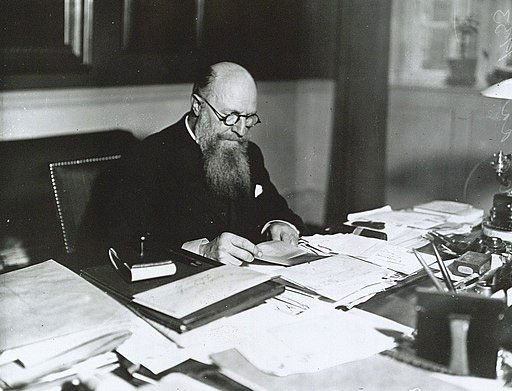
1924
Thorvald Stauning bliver statsminister
I 1924 blev Thorvald Stauning Danmarks første socialdemokratiske statsminister, i en regering der inkluderede den første kvindelige minister, Nina Bang.
-
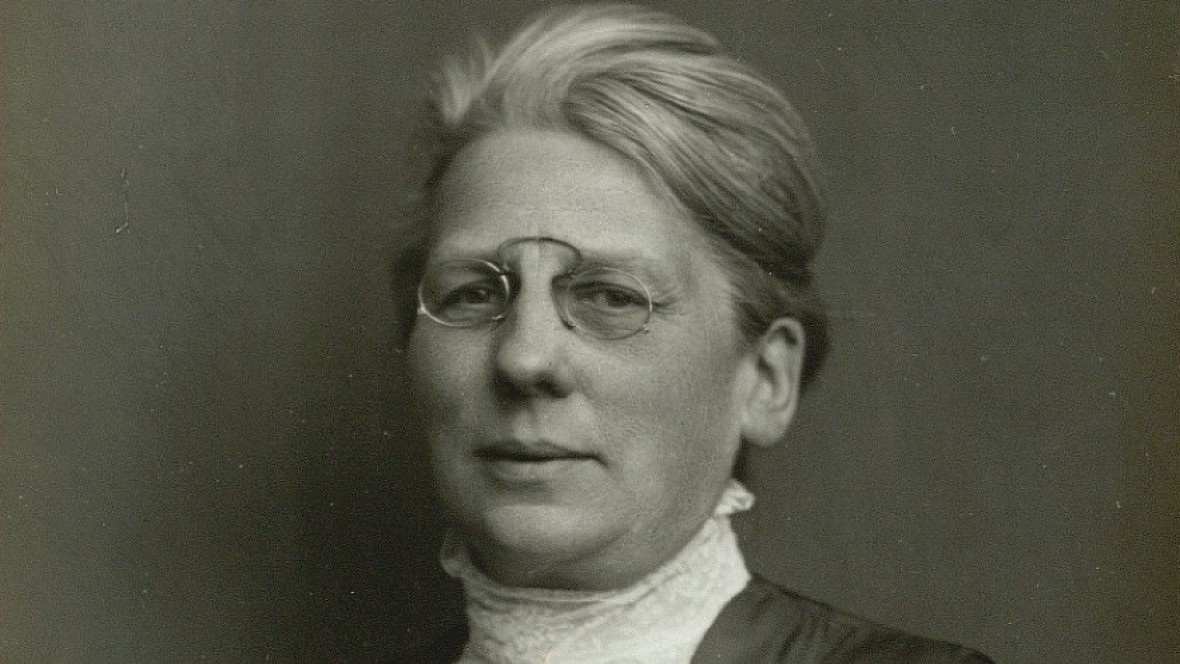
1924
Nina Bang bliver Danmarks første kvindelige minister
I 1924 blev Nina Bang udnævnt til undervisningsminister i Thorvald Staunings socialdemokratiske regering, og blev dermed Danmarks første kvindelige minister. Hun var samtidig en af verdens første kvinder til at besidde en ministerpost i en parlamentarisk regering.
-
1928
Kirkens del styrtede i havet
I 1928 styrtede noget af Højerup kirke i havet, fordi bølgerne over tid havde reduceret klinten ved Østersøen. -
1928
Opdagelse af penicillin i 1928
Inden penicillinen blev opdaget i 1928, havde mange influenzapatienter, der også fik lungebetændelse, ofte dødelige udfald. Den manglende tilgængelighed af penicillin under Den Spanske Syge i 1918-20 førte til højere dødsfald blandt de smittede. -

1928
Premiere på La passion de Jeanne d'Arc
Carl Th. Dreyer opnåede berømmelse med filmen La passion de Jeanne d’Arc fra 1928, kendt for sine nærbilleder og langsomme filmtempo.
-

1929
Børskrakket på Wall Street
Det store børskrak på Wall Street i New York, oktober 1929, førte til en international økonomisk krise, der særlig ramte dansk landbrug og medførte høj arbejdsløshed.
1930s
-
1930
Økonomisk krise i 1930'erne
I 1930'erne var verden i en dyb økonomisk krise, som også ramte Danmark. Arbejdsløsheden voksede kraftigt, hvilket udløste mange konflikter på arbejdsmarkedet og gav Socialdemokratiet stor opbakning. -
1931
Opførelse af Aarhus Universitet
Aarhus Universitet blev opført 1931-1933 med målet om at skabe en akademisk landsby præget af åbenhed og harmoni, og universitetet integrerer mange formål i en helhed. -
1933
Kanslergadeforliget og socialreformen
Den 30. januar 1933 indgik regeringen (Socialdemokratiet og Radikale Venstre) og Venstre det såkaldte Kanslergadeforlig, som både indeholdt økonomisk hjælp til landbruget og en omfattende socialreform. Reformen samlede 55 socialpolitiske love i fire folkeforsikringslove, afskaffede de fleste deklasseringsbestemmelser og indførte klare regler for offentlig hjælp, så modtagere ikke længere mistede borgerrettigheder. -

1935
Indvielse af Lillebæltsbroen
Den første bro over Lillebælt mellem Jylland og Fyn blev indviet i 1935.
-
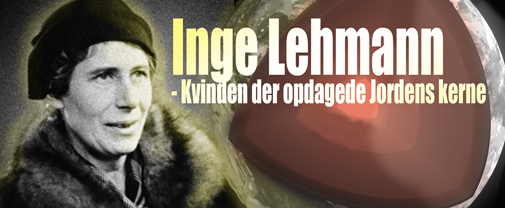
1936
Inge Lehmanns opdagelse af Jordens indre kerne
I 1936 offentliggjorde seismologen Inge Lehmann en banebrydende artikel, hvor hun på baggrund af jordskælvsobservationer – blandt andet fra New Zealand – påviste, at Jorden har en fast indre kerne inde i den flydende yderkerne. Opdagelsen vakte international opmærksomhed og blev senere udnyttet af det amerikanske militær under Den Kolde Krig.
-
9. november 1938
Krystalnatten i Tyskland
Krystalnatten fandt sted den 9. november 1938, hvor nazisterne smadrede og nedbrændte jødiske butikker, synagoger, boliger og skoler i Tyskland. Denne begivenhed blev symbolsk markedsført i Danmark, som nævnt i en antisemitisk handling i 2019.
-
1938
Udgivelse af romanen 'Ersinngitsup piumasaa'
Romanen 'Ersinngitsup piumasaa', skrevet af Hans Lynge i 1938, handler om hævn og konflikten mellem traditionel ære og moderne samvittighed. Hans Lynge var en fremtrædende figur i grønlandsk kunst og litteratur og var politisk aktiv som fortaler for grønlandsk selvstændighed. -
1939
Barbara udgivet posthumt
Jørgen-Frantz Jacobsens hovedværk 'Barbara' udkom i 1939, året efter hans død. Romanen foregår i 1700-tallet på Færøerne og omhandler Barbara, en yngre kvinde, der har stor tiltrækning på mænd og skaber kontrovers i et lille religiøst samfund. -
1939
Hitlers angreb på Polen
Hitlers angreb på Polen i september 1939 medførte, at Storbritannien og Frankrig erklærede Tyskland krig. Dermed var 2. Verdenskrig brudt ud i Europa.
1940s
-

1940
Børge Mogensens møbelprogram
I 1940'erne udviklede Børge Mogensen et funktionalistisk møbelprogram for FDB, som præger både danske hjem og offentlige bygninger med sit enkle udtryk.
-
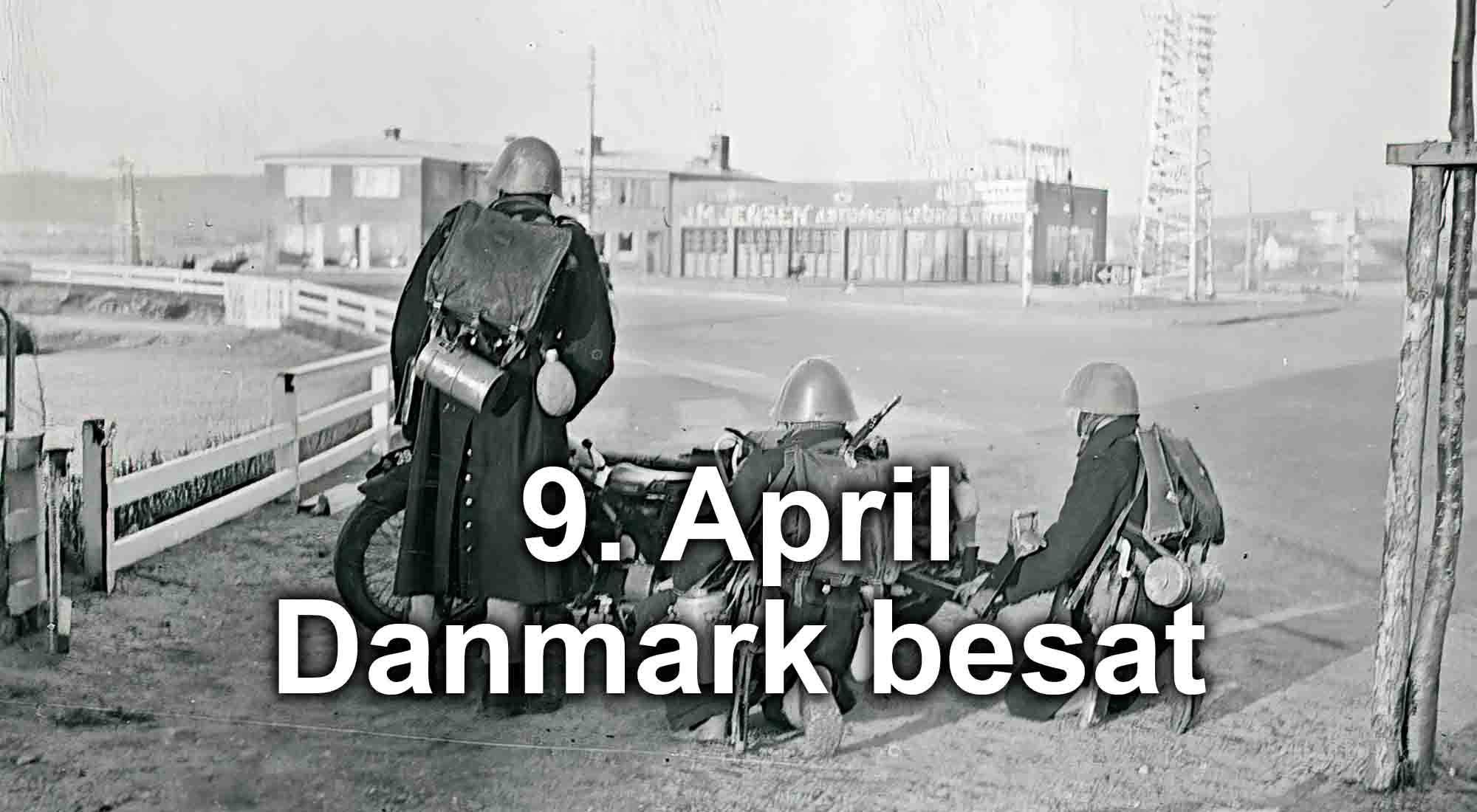
9. april 1940
Danmark besat af Tyskland
Danmark og Norge blev angrebet og besat af det tyske militær den 9. april 1940. Tyskland krævede, at Danmark skulle samarbejde med besættelsesmagten, hvilket Danmark indvilligede i, selvom landet forblev formelt suverænt. Tysklands besættelse af Danmark skyldtes især interesse i Norge og jernmalmtransport fra Nordsverige.
-
9. april 1940
Danmarks overgivelse april 1940
Danmarks hurtige overgivelse til tyskerne i april 1940 og den efterfølgende samarbejdspolitik med tyskerne medførte relativt lave dødstal og begrænsede ødelæggelser under besættelsen.
-

1940
Holger Danske modstandsgruppe dannes
Under den tyske besættelse af Danmark 1940-45 blev en vigtig modstandsgruppe navngivet Holger Danske, inspireret af sagnhelten, der ifølge myten vil vågne for at forsvare Danmark.
-

1940
Storbritannien besætter Færøerne
Da Danmark blev besat af tyskerne i 1940, blev Færøerne besat af Storbritannien for at beskytte transportruterne mellem USA og Europa mod tysk besættelse.
-

25. april 1940
Merkið anerkendt af Storbritannien
Grundet den tyske besættelse af Danmark i 1940 og den britiske besættelse af Færøerne, krævede Storbritannien, at færøske skibe kunne skelnes fra danske. Derfor blev Merkið godkendt som Færøernes flag den 25. april 1940.
-
1940
Storbritannien besætter Island
I maj 1940 besatte Storbritannien Island for at forhindre en tysk invasion. Dette skyldtes Islands strategiske beliggenhed i Nordatlanten, hvor øen kunne bruges som base for fly og skibe på vej fra USA til Europa under 2. verdenskrig. -
1941
Invasion af Sovjetunionen og angreb på Pearl Harbor
To afgørende begivenheder i 1941 var Tysklands invasion af Sovjetunionen (Operation Barbarossa) den 22. juni og Japans bombning af den amerikanske flåde i Pearl Harbor den 7. december. Disse begivenheder trak Sovjetunionen og USA ind i krigen på allieret side. -
1941
USA opretter baser i Grønland
Under 2. Verdenskrig blev Grønland ikke besat af tyskerne. I 1941 indgik Danmarks ambassadør i Washington DC, Henrik Kauffmann, en aftale med USA, som gav amerikanerne lov til at oprette militære baser i Grønland.
-
1942
Bygning af bunkere i Jylland
Fra 1942 blev der bygget mange bunkere og lagt landminer langs hele Jyllands vestkyst som en del af det tyske forsvarsværk Atlantvolden. -
1942
Niels Ebbesen forbudt, trykt i 1942
Kaj Munks drama 'Niels Ebbesen', skrevet i opgør med nazismen, blev forbudt og trykt i 1942. Stykket fortæller om den jyske adelsmand Niels Ebbesen, der i 1340 dræber en tysk greve, og intenderet opfordre danskerne til modstand mod nazismen. -
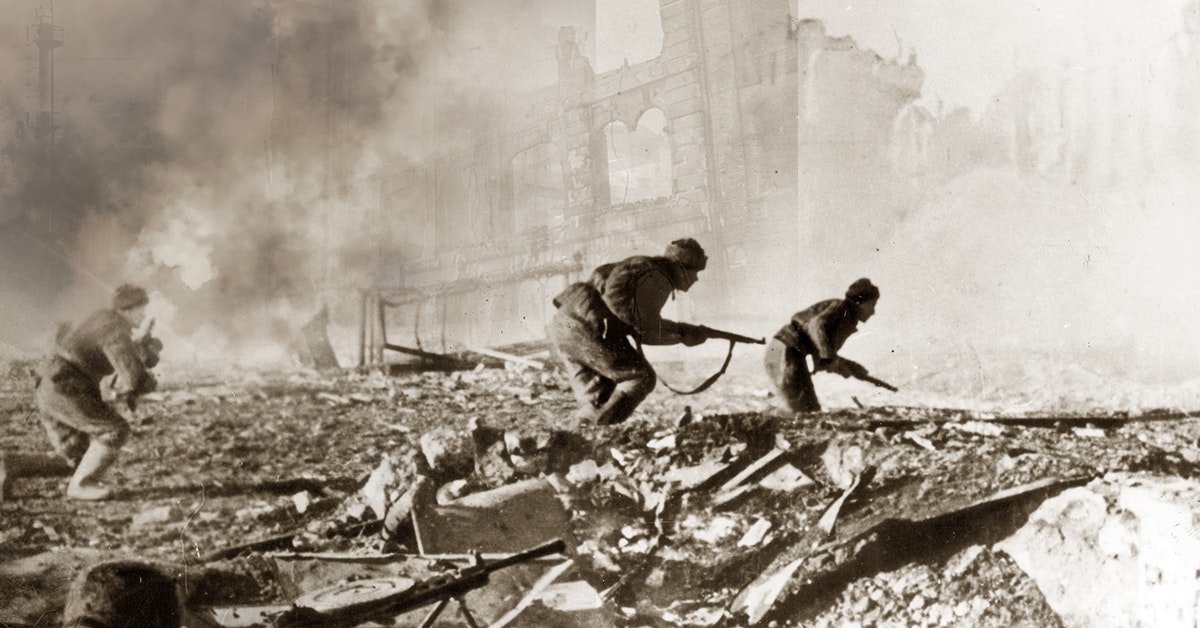
1942
Slaget ved Stalingrad
Slaget ved Stalingrad i 1942-43 var et af de blodigste slag i 2. Verdenskrig, hvor Sovjetunionen besejrede Tyskland og det markerer begyndelsen til Tysklands nederlag i 1945.
-
1942
Fremvækst af den danske modstandsbevægelse under besættelsen
Under den tyske besættelse af Danmark (1940‑1945) voksede en organiseret modstandsbevægelse gradvist frem. Fra 1942 tiltog modstanden markant, hvilket udløste en krise i forholdet til besættelsesmagten og førte til dannelsen af en ny regering ledet af Erik Scavenius, som ønskede at fortsætte samarbejdspolitikken. Modstandsgrupper stod bag sabotage, illegale blade og hjælp til forfulgte og spillede en central rolle frem til befrielsen i 1945.
-
29. august 1943
Afbrudt samarbejdspolitik med Nazi-Tyskland
Den 29. august 1943, efter store strejker i danske byer og en krise i det dansk-tyske forhold, indgav regeringen sin afskedsbegæring efter ikke at have indfriet tyske krav. Den danske flåde sænkede hovedparten af sine skibe for ikke at falde i tyske hænder.
-
1943
Forbundsloven udløber
I 1943 udløb Forbundsloven fra 1918, som gav Island selvstyre. På dette tidspunkt var Danmark besat af Tyskland og havde ikke mulighed for at genforhandle loven, hvilket banede vej for Islands beslutning om fuld selvstændighed året efter. -
september 1943
Frihedsrådet oprettet
Frihedsrådet blev oprettet i september 1943 som en illegal komité, hvor lederne fra de forskellige modstandsbevægelser koordinerede modstanden mod den tyske besættelsesmagt.
-
1943
Premiere på Vredens Dag
Carl Th. Dreyers film Vredens Dag fra 1943 sikrede Dreyer berømmelse og er kendt for sin fremstilling af nærbilleder og klip. -

oktober 1943
Redningen af de danske jøder under besættelsen
Under den tyske besættelse af Danmark 1940‑1945 levede der omkring 8.000 jøder i landet. I oktober 1943 forsøgte besættelsesmagten at arrestere dem, men med hjælp fra danske medborgere, modstandsfolk og fiskere blev over 7.000 fragtet i hemmelighed over Øresund til Sverige. Omtrent 500 blev dog deporteret til koncentrationslejren Theresienstadt, men flertallet overlevede takket være vedvarende dansk pres. Dermed blev næsten hele den danske jødiske befolkning reddet fra Holocaust.
-
1944
Island løsriver sig fra Danmark
I 1944 ophørte den officielle danske tilknytning til Island, der havde varet siden 1380 – et tilhørsforhold på 564 år. En folkeafstemning blandt islændingene gav næsten enstemmig støtte til fuld selvstændighed, og Republikken Island blev proklameret den 17. juni 1944, som siden er blevet Islands nationaldag.
-
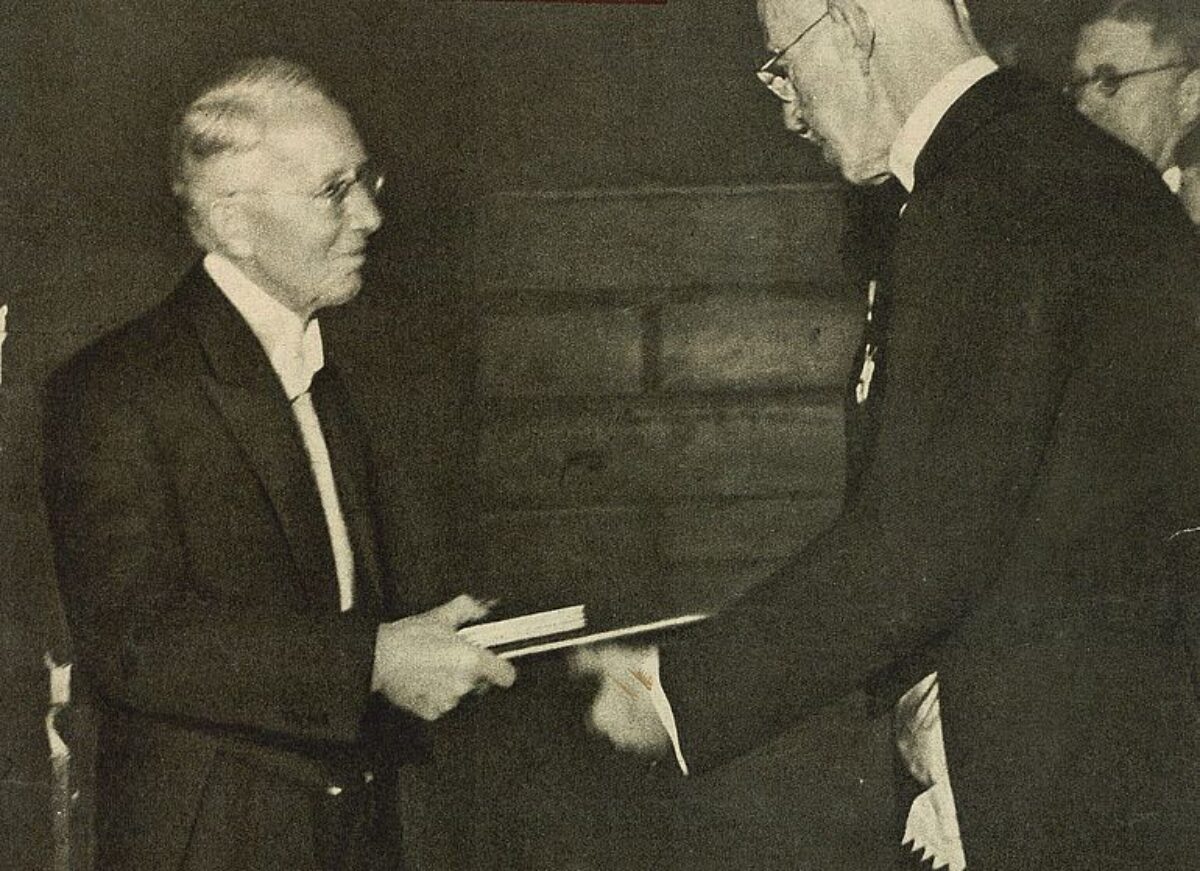
1944
Johannes V. Jensen og Nobelprisen
I 1944 modtog Johannes V. Jensen Nobelprisen i litteratur for sine værker, inklusiv Kongens Fald og Himmerlandshistorier.
-
1944
Start på batterie Vogelnest
I 1944 begyndte den nazistiske besættelsesmagt at anlægge 'Batterie Vogelnest' (også kaldet Tirpitz) ved Blåvand, som en del af Atlantvolden. -
juli 1944
Stor strejke i København
En stor strejke i København i juli 1944 førte til øget kontakt mellem modstandsbevægelse og politikere, hvilket resulterede i samarbejdet mellem Frihedsrådet og de danske politikere om at få Danmark anerkendt som allieret mod Tyskland.
-
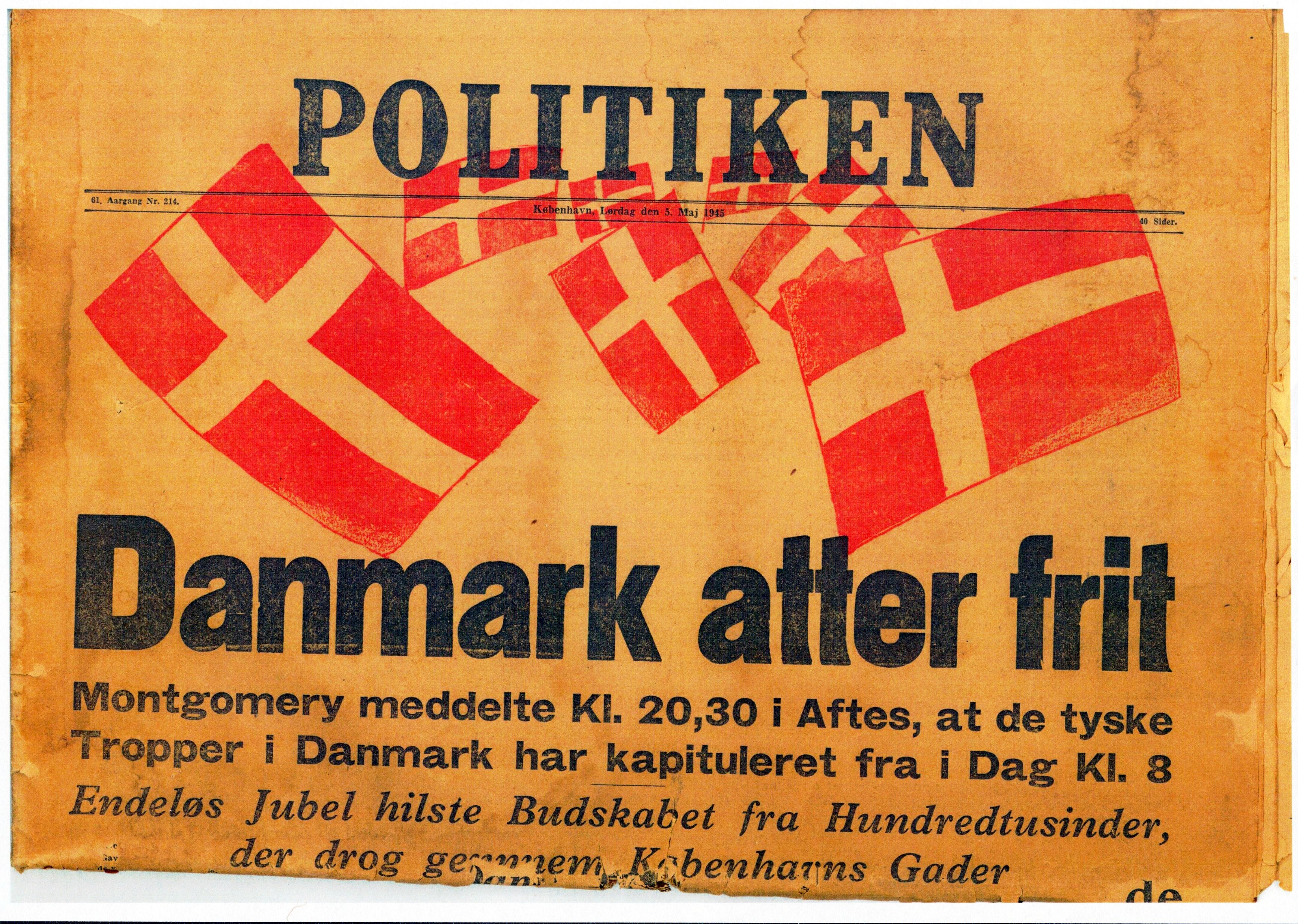
5. maj 1945
Danmarks befrielse
Den 5. maj 1945 markerer Danmarks officielle befrielse, da de tyske styrker i landet overgav sig og britiske tropper rykkede ind. På Bornholm nægtede de tyske garnisoner dog at kapitulere, hvilket førte til sovjetisk bombardement 7.–8. maj. Ved befrielsen stod flere tyske befæstningsanlæg, blandt andet bunkeren Tirpitz ved Blåvand, stadig ufuldendte.
-

1945
Grundlæggelsen af FN efter 2. Verdenskrig
Kort efter afslutningen af 2. Verdenskrig blev De Forenede Nationer (FN) stiftet i 1945 for at sikre international fred og forhindre en ny verdenskrig. Danmark var med blandt grundlæggerne og har været medlem siden stiftelsen samme år.
-
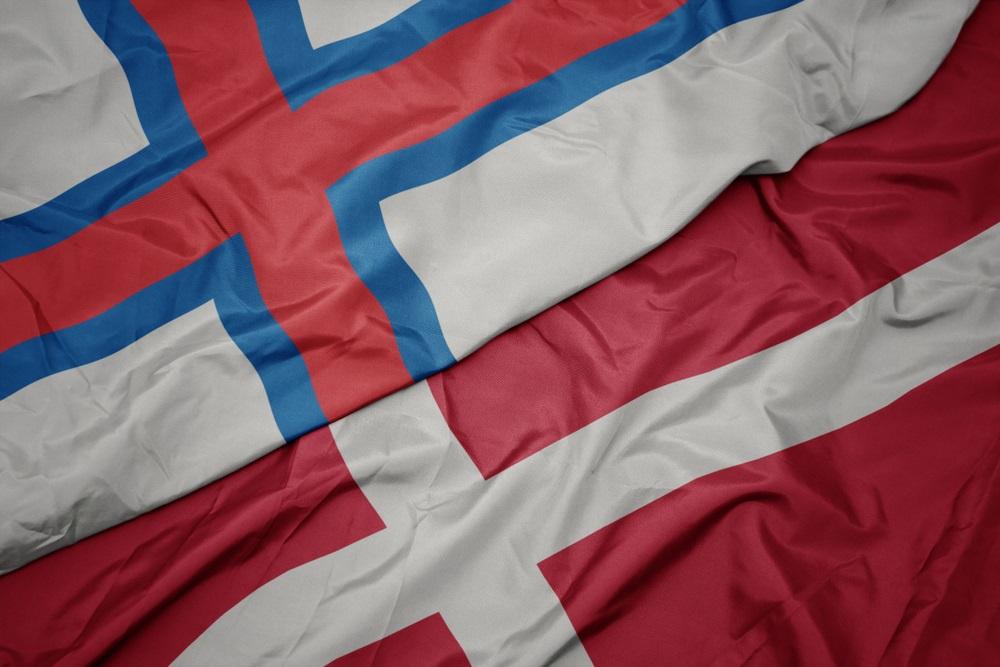
1945
Færøerne returneret til Danmark
Efter afslutningen af 2. Verdenskrig i 1945 gav Storbritannien Færøerne tilbage til Danmark, hvilket ledte til en voksende selvstændighedsbevægelse på øerne.
-
1945
Første opførsel af Niels Ebbesen
Kaj Munks drama 'Niels Ebbesen', som tidligere var forbudt, blev opført første gang i 1945 efter Danmarks befrielse fra den tyske besættelse. Stykket handler om kampen mod nazismens undertrykkelse. -
1945-1950
Henrettelser efter Anden Verdenskrig
De sidste henrettelser i Danmark fandt sted i perioden 1945-50. I alt blev 78 personer idømt dødsstraf for at have hjulpet den tyske besættelsesmagt under krigen. 46 af de 78 dødsdomme blev gennemført. -

1945
Krigsflygtninge til Danmark
Omkring slutningen af Tysklands besættelse i 1945 kom knap 240.000 krigsflygtninge fra Tyskland til Danmark.
-
1945
Øget udbygning af velfærdssamfundet
I perioden 1945-80 oplevede Danmark en betydelig reduktion i uligheden. Dette skyldtes især den hurtige udbygning af velfærdssamfundet, betydelige lønstigninger og lange perioder med lav ledighed. -
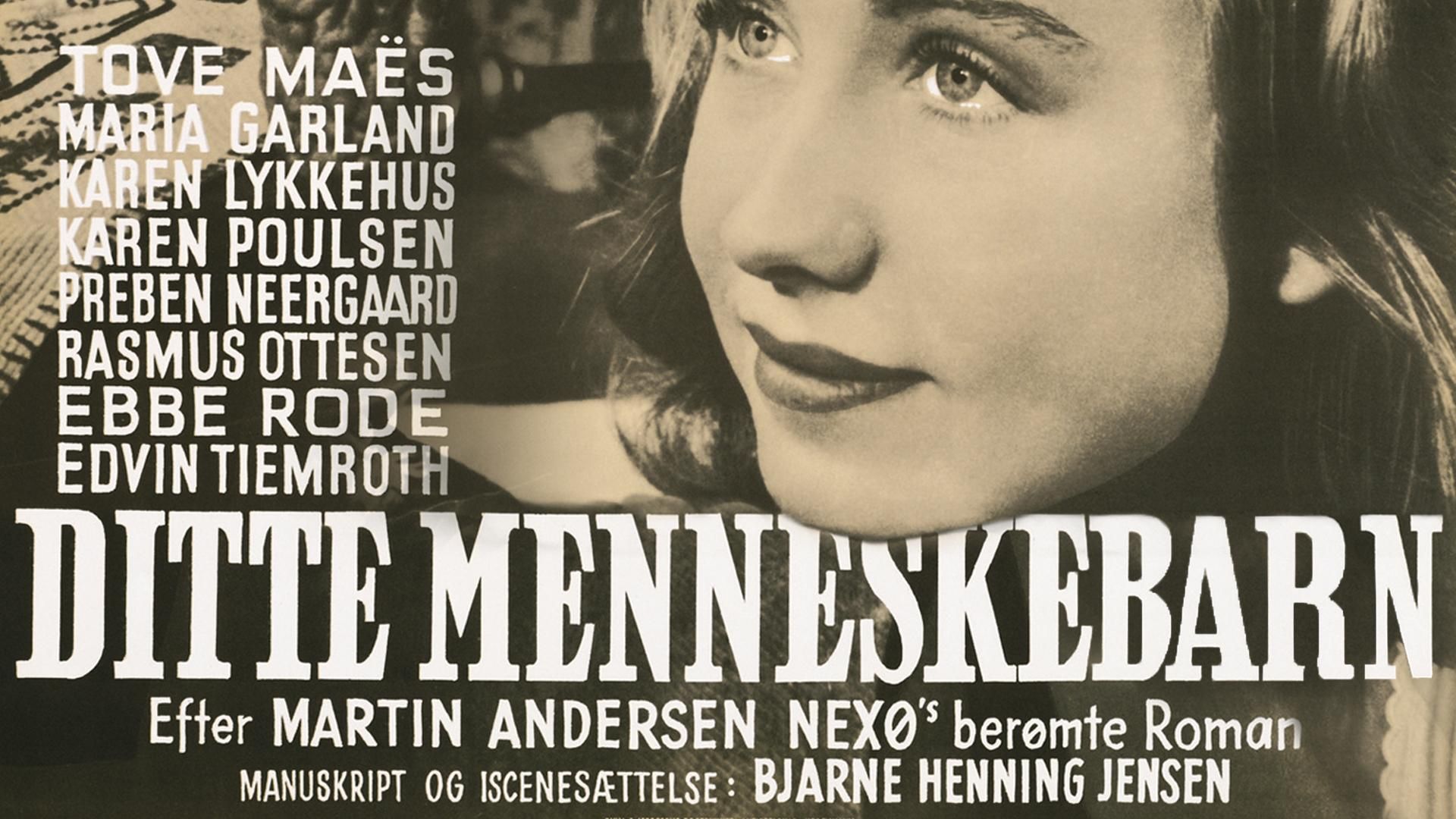
1946
Premiere på Ditte Menneskebarn
Ditte Menneskebarn fra 1946, instrueret af Astrid Henning-Jensen og Bjarne Henning-Jensen, skildrer en fattig pige i begyndelsen af det 20. århundrede.
-
1946
Sovjets tilstedeværelse på Bornholm
I besættelsens sidste dage og frem til foråret 1946 forblev sovjetiske styrker på Bornholm, efter at have angrebet øen, da tyskerne nægtede at overgive sig. -
1946
Vetoretten bruges første gang
Siden 1946 har vetoretten været brugt 321 gange i FN's Sikkerhedsråd, flest gange af Sovjetunionen/Rusland og USA. -

1947
Premiere på Soldaten og Jenny
Filmen Soldaten og Jenny fra 1947 af Johan Jacobsen skildrer forholdet mellem en ung kvinde og en soldat samt konsekvenserne af en ulovlig abort.
-
1948
Hjemmestyre indført på Færøerne
Efter forhandlinger og en folkeafstemning fik Færøerne hjemmestyre ved lov i 1948, med Lagtinget som en folkevalgt og lovgivende forsamling. -
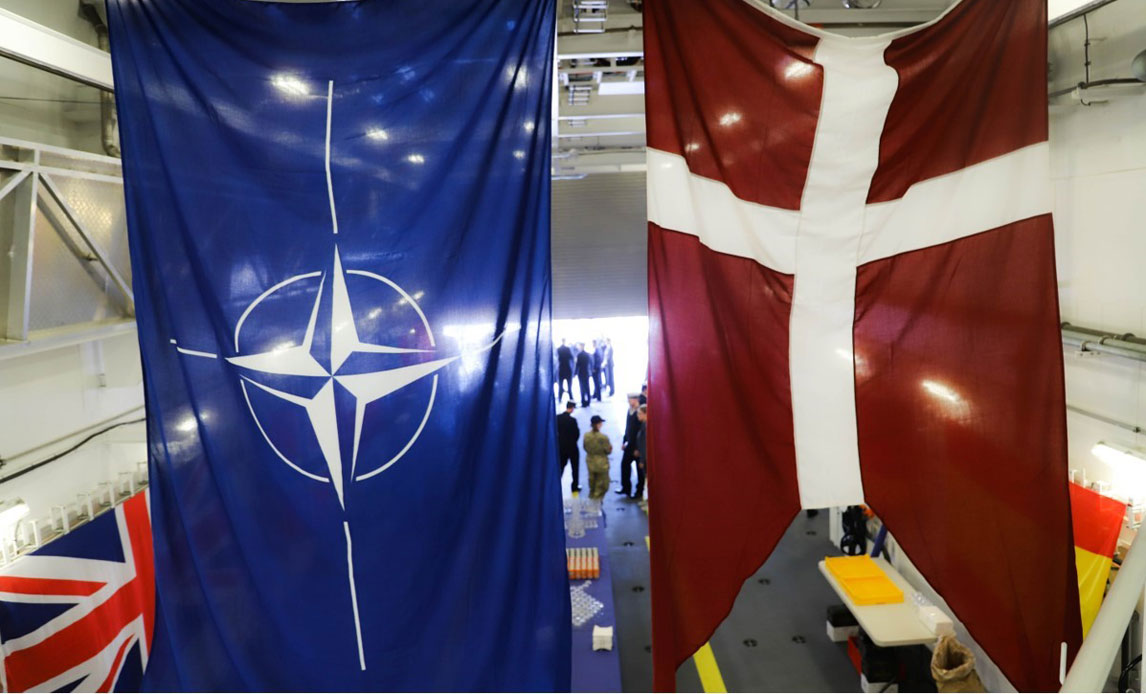
1949
Danmark bliver medlem af NATO
I 1949 opgav Danmark sin traditionelle neutralitetspolitik og tilsluttede sig NATO – en forsvarsalliance med USA, Canada, Tyrkiet og flere vesteuropæiske lande – for at opnå øget beskyttelse under Den Kolde Krig. Trods medlemskabet holdt Danmark en relativt lav militær profil frem til Den Kolde Krigs afslutning omkring 1990.
-
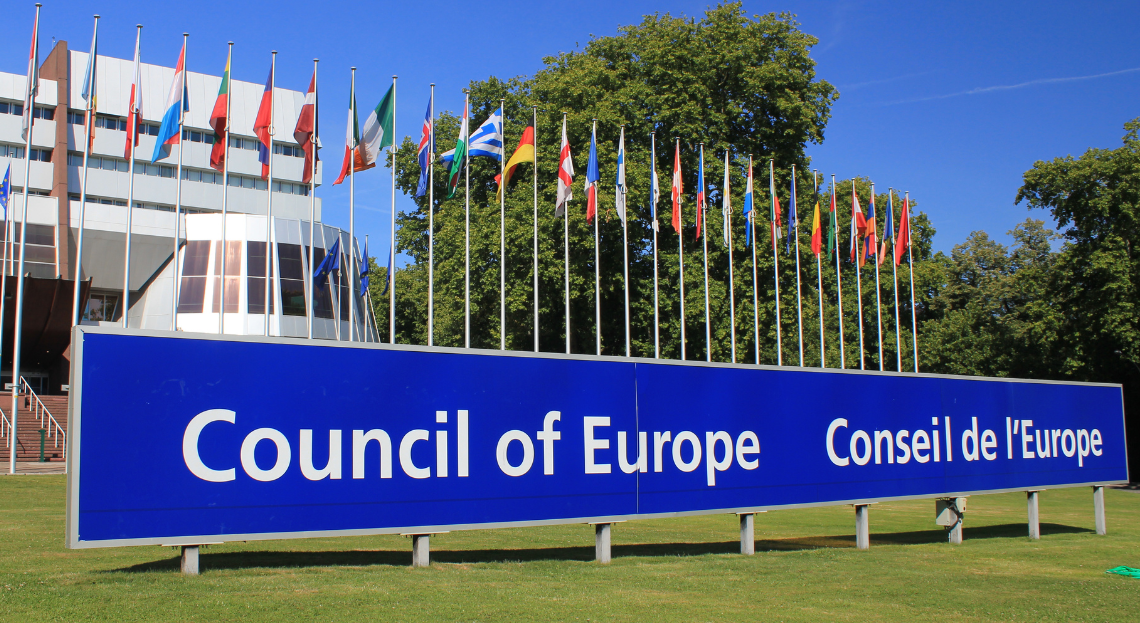
1949
Danmark medlem af Europarådet
Danmark blev medlem af Europarådet i 1949, da det blev oprettet med ti vesteuropæiske demokratier som medlemmer. Europarådet er en selvstændig organisation i Europa og ikke en EU-institution.
1950s
-

1950
'De fortabte spillemænd' udgivet
William Heinesens hovedværk 'De fortabte spillemænd' udkom i 1950. Bogen handler om en gruppe spillemænd, der lever et liv med musik, alkohol og kvinder, hvilket skaber konflikt med den lokale, religiøse befolkning.
-
1950
Anden industrialiseringsbølge i Danmark
Den anden store bølge af industrialisering i Danmark fandt sted fra slutningen af 1950’erne til omkring 1970. Under denne periode faldt andelen af beskæftigede inden for industrien, mens servicesektoren voksede. -
1950
Bygningen af Thule Air Base
I begyndelsen af 1950’erne byggede amerikanerne en base i Qaanaaq (Thule) i Nordgrønland, hvilket førte til flytningen af flere grønlandske familier. Basen var central for luftforsvaret af USA og NATO. -
1950
Filmatisering af De røde heste
I 1950 blev Morten Korchs roman De røde heste filmatiseret af Alice O’Fredericks og Jon Iversen, hvilket blev Danmarks mest sete film. -

1950
Jørn Utzons operahus i Sydney
I slutningen af 1950'erne tegnede Jørn Utzon det ikoniske operahus i Sydney, Australien, udformet som store opretstående skaller, der banede vejen for en eksperimenterende og legende byggestil.
-
1950
Medlemstal for politiske partier i 1950
Omkring 1950 var cirka 650.000 personer medlem af et politisk parti i Danmark. Dette svarede til næsten hver fjerde person med valgret til Folketingsvalg. Siden da er medlemstallet faldet betydeligt. -
1950
Menneskerettighedskonventionen vedtaget
I 1950 vedtog Europarådet Den Europæiske Menneskerettighedskonvention, som har til formål at sikre, at medlemslandene overholder grundlæggende friheds- og menneskerettigheder, herunder ytrings-, forsamlings- og religionsfrihed. -
1951
Aftale om USA's militære aktiviteter
I 1951 underskrev Danmark og USA en aftale om USA’s militære aktiviteter i Grønland. Samme år begyndte amerikanerne at anlægge en stor luftbase ved Qaanaaq (Thule). På basen byggede USA også en radarstation, der kunne overvåge luftrummet over Grønland. -
1952
Oprettelse af Det Europæiske Kul- og Stålfællesskab
Det Europæiske Kul- og Stålfællesskab blev oprettet i 1952 af seks europæiske lande med formålet at understøtte fred og samarbejde samt at genrejse Europa økonomisk og socialt efter krigens ødelæggelser. -
1953
Grundlovsændring i Danmark
Ved folkeafstemningen 5. juni 1953 blev den nuværende danske grundlov vedtaget. Ændringen afskaffede Landstinget og indførte et etkammersystem, ændrede tronfølgen så tronen kan arves af en kvinde, og indførte nye regler for folkeafstemninger. Siden 1953 er der gennemført 16 folkeafstemninger – over halvdelen om Danmarks forhold til EU. -
1953
Grønland under grundloven som del af Danmark
Indtil 1953 var Grønland en koloni under Danmark. Ved grundlovsændringen i 1953 kom Grønland under grundloven på lige fod med Danmark og Færøerne. -
1953
Parlamentarismen indføjes i grundloven
I 1953 blev parlamentarismen indføjet i selve grundlovsteksten, hvilket betyder, at en regering ikke kan dannes eller blive ved magten, hvis den har et flertal i Folketinget imod sig. -

1953
Victor Borges succes i USA
Fra 1953 til 1956 optrådte den dansk-amerikanske Victor Borge med sit onemanshow 'Comedy in the Music' på Broadway, New York. Showet blev en forløber for nutidens standup-komedie og blev opført over 800 gange.
-
1953-1972
Øget ferieperiode i Danmark
Ferieperioden blev udvidet fra to til fire uger mellem 1953 og 1972 i Danmark. -
1955
København-Bonn erklæringerne
I 1955 blev mindretals rettigheder på begge sider af grænsen sikret ved København-Bonn-erklæringerne, hvilket bidrog til en fredelig udvikling i grænselandet. -
1955
Premiere på Ordet
Carl Th. Dreyers film Ordet fra 1955, inspireret af et drama af Kaj Munk, indeholder en gribende scene om et mirakuløst livsopvækkelse. -
1955
Stiftelse af Warszawa-pagten
I 1955 blev Warszawa-pagten oprettet som en forsvarsalliance ledet af Sovjetunionen, med stor indflydelse på Østeuropas lande under Den Kolde Krig. -
1956
Indførelse af folkepensionen i Danmark
I 1956 blev folkepensionen indført som et led i udbygningen af det danske sociale sikkerhedsnet. Reformen gav alle ældre borgere ret til pension uanset indkomst og markerede et vigtigt skridt i udviklingen af velfærdsstaten. -
1956
Ungarns opstand mod kommunisme
I 1956 var der en folkelig opstand mod det kommunistiske styre i Ungarn, som havde afgørende betydning for splittelsen af DKP i Danmark. Dette førte til dannelsen af SF i 1959. -
1956
Ungarske flygtninge til Danmark
Ungarske flygtninge kom til Danmark som følge af opstanden i Ungarn i 1956. -
1957-1973
Begyndelsen på økonomisk højkonjunktur i Danmark
Fra 1957 til 1973 oplevede Danmark en økonomisk højkonjunktur. Der var fuld beskæftigelse, og de fleste indkomster voksede støt i denne periode, som ofte omtales som 'De glade 60'ere'. -
1958
Det Europæiske Fællesskab oprettes
I 1958 indledte Frankrig, Italien, Tyskland og Benelux-landene et økonomisk samarbejde, som udviklede sig til Det Europæiske Fællesskab (EF), med det formål at styrke handlen mellem medlemslandene og sikre freden via et stærkt samarbejde. -
1958-1974
Reduktion af arbejdsugen i Danmark
Arbejdsugen blev løbende kortere, fra 48 timer til 40 timer mellem 1958 og 1974. -
1958
Udvidelse til Det Europæiske Økonomiske Fællesskab
I 1958 blev Det Europæiske Kul- og Stålfællesskab udvidet med Det Europæiske Økonomiske Fællesskab og Det Europæiske Atomenergifællesskab, der senere blev til De Europæiske Fællesskaber (EF). -

1959
Dannelsen af Socialistisk Folkeparti: SF
I 1956 var der en folkelig opstand mod det kommunistiske styre i Ungarn, som havde afgørende betydning for splittelsen af DKP i Danmark. Dette førte til dannelsen af SF i 1959.
1960s
-

1960
Danske aviser frigør sig fra partipolitik
I løbet af 1960'erne ændrede de danske aviser karakter og frigjorde sig fra de politiske partier, selvom de fleste stadig havde politiske holdninger. Aviserne, der tidligere fungerede som talerør for partierne, begyndte nu at have egne kommentarer til politiske begivenheder.
-

1960
Forandringer i danske familier
Siden 1960'erne har familier i Danmark været påvirket af nye kulturelle strømninger og samlivsformer, herunder fremkomsten af forskellige familietyper ud over det traditionelle ægteskab mellem mand og kvinde.
-

1960
Øget eksport fra industrien i Danmark
Fra begyndelsen af 1960'erne eksporterede Danmark flere varer fra industrien end fra landbruget.
-

1963
Danmark vinder Eurovision for første gang
Danmark vandt Eurovision Song Contest for første gang i 1963 med sangen 'Dansevise', fremført af Grethe Ingmann og Jørgen Ingmann.
-

1964
Folketinget vedtager daginstitutionspladser
I 1964 vedtog Folketinget, at kommunerne skulle oprette det nødvendige antal daginstitutionspladser, så alle familier kunne få deres børn i vuggestue og børnehave.
-
1964
Udvidelse af folkepensionslovene
I 1964 blev folkepensionslovene yderligere udvidet, så folkepension blev tilgængelig for alle ældre borgere. -
1966
Lovligt salg af p-piller i Danmark
Fra 1966 kunne p-piller sælges lovligt i Danmark. Kvinder fik dermed adgang til et nemt præventionsmiddel, så de selv kunne styre, om de ønskede at blive gravide og få børn. P-pillen fik derfor afgørende betydning for kvinders seksuelle frigørelse. -
1966
Premiere på Sult
Henning Carlsens film Sult fra 1966, baseret på Knut Hamsuns roman, handler om en desperat ung forfatter i det tidligere Kristiania.
-
1967-1968
Danmark i Sikkerhedsrådet 1967-68
Danmark har været medlem af FN's Sikkerhedsråd i perioden 1967-68. -
1967
Forbud mod lærerat slå i folkeskolen
I 1967 blev det helt forbudt for lærerne at slå eleverne i den danske folkeskole. Denne ændring markerede et skift til en pædagogik baseret på øget dialog og samarbejde mellem børn og voksne. -
1967
Tove Ditlevsens erindringer
Tove Ditlevsen udgav sin erindringsserie 'Barndom, Ungdom og Gift' fra 1967 til 1971, som har skabt stor interesse i udlandet. -

1968-1971
Hilmar Baunsgaard bliver statsminister
Hilmar Baunsgaard fra Det Radikale Venstre blev statsminister fra 1968 til 1971, mens hans parti var det mindste i regeringen, der også bestod af Venstre og Det Konservative Folkeparti.
-
1968
Premiere på Farvel Thomas
I 1968 blev Leif Panduros tv-spil 'Farvel Thomas' vist. Stykket handler om en mand, der efter en skilsmisse, havner i en dyb krise og ensomhed. Det blev populært midt i en periode med stigende velstand i Danmark. -
1968
Start af Olsenbanden-serien
Erik Balling startede filmserien Olsenbanden i 1968, som blev en populær komedie om en dansk forbryderbande med store, men ofte mislykkede planer. -
1968
Studenteroprør mod professorvælde
I 1968 og årene efter gjorde mange studerende og yngre undervisere oprør mod det såkaldte professorvælde på universiteterne. De krævede mere indflydelse, nye ledelses- og undervisningsformer og et andet indhold i studierne, og det lykkedes dem at få mange af deres krav igennem. -
1968
Tjekkoslovakiske flygtninge til Danmark
Flygtninge fra Tjekkoslovakiet kom under den sovjetiske invasion i 1968 til Danmark.
1970s
-
1970
Andel af gifte 30-årige kvinder i 1970
I 1970 var 88 procent af alle 30-årige kvinder i Danmark gift. Denne andel er siden faldet markant. -
1970
Åbning af anden Lillebæltsbro
Endnu en Lillebæltsbro blev åbnet i 1970, der forbinder Jylland og Fyn. -
1971
Danida bliver ansvarlig for udviklingspolitik
Siden 1971 har Danida været ansvarlig for Danmarks udviklingspolitik. Danida fungerer som en selvstændig afdeling under Udenrigsministeriet. -
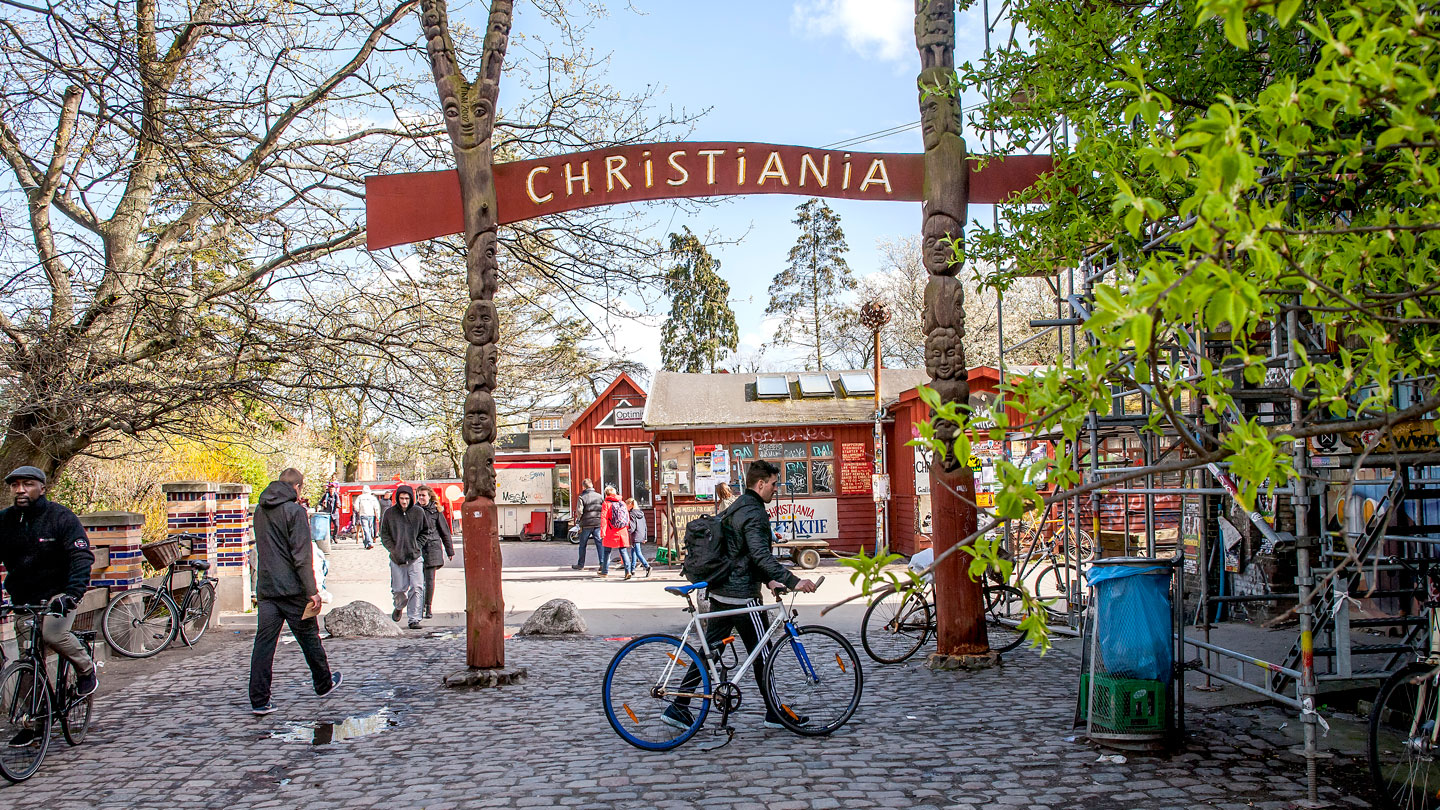
1971
Oprettelse af fristaden Christiania
Fristaden Christiania i København blev oprettet i 1971, da unge besatte en forladt militærkaserne, Bådsmandsstrædes Kaserne. Herefter bosatte op mod 1.000 personer sig på Christiania og forsøgte at udleve mange af tidens nye ideer. Fristaden Christiania eksisterer stadig.
-
1971
Premiere på Dødens triumf
I 1971 opførtes balletten 'Dødens triumf' skabt af Flemming Flindt og rockbandet Savage Rose. Balletten blev kendt for sin skarpe kritik af samfundet og forargede med scener hvor dansere optrådte nøgne. -
1972
Danmark siger ja til EF-medlemskab
Ved folkeafstemningen i oktober 1972 sagde 63,3 % af de danske vælgere ja til medlemskab af Det Europæiske Fællesskab (EF). Danmark trådte formelt ind i EF den 1. januar 1973. Tilhængerne fremhævede økonomiske gevinster og adgang til EF’s landbrugsstøtte, mens modstanderne frygtede tab af national selvbestemmelse. Siden da er der afholdt ni folkeafstemninger om EU-relaterede spørgsmål, hvoraf seks er blevet vundet af ja-siden og tre af nej-siden.
-
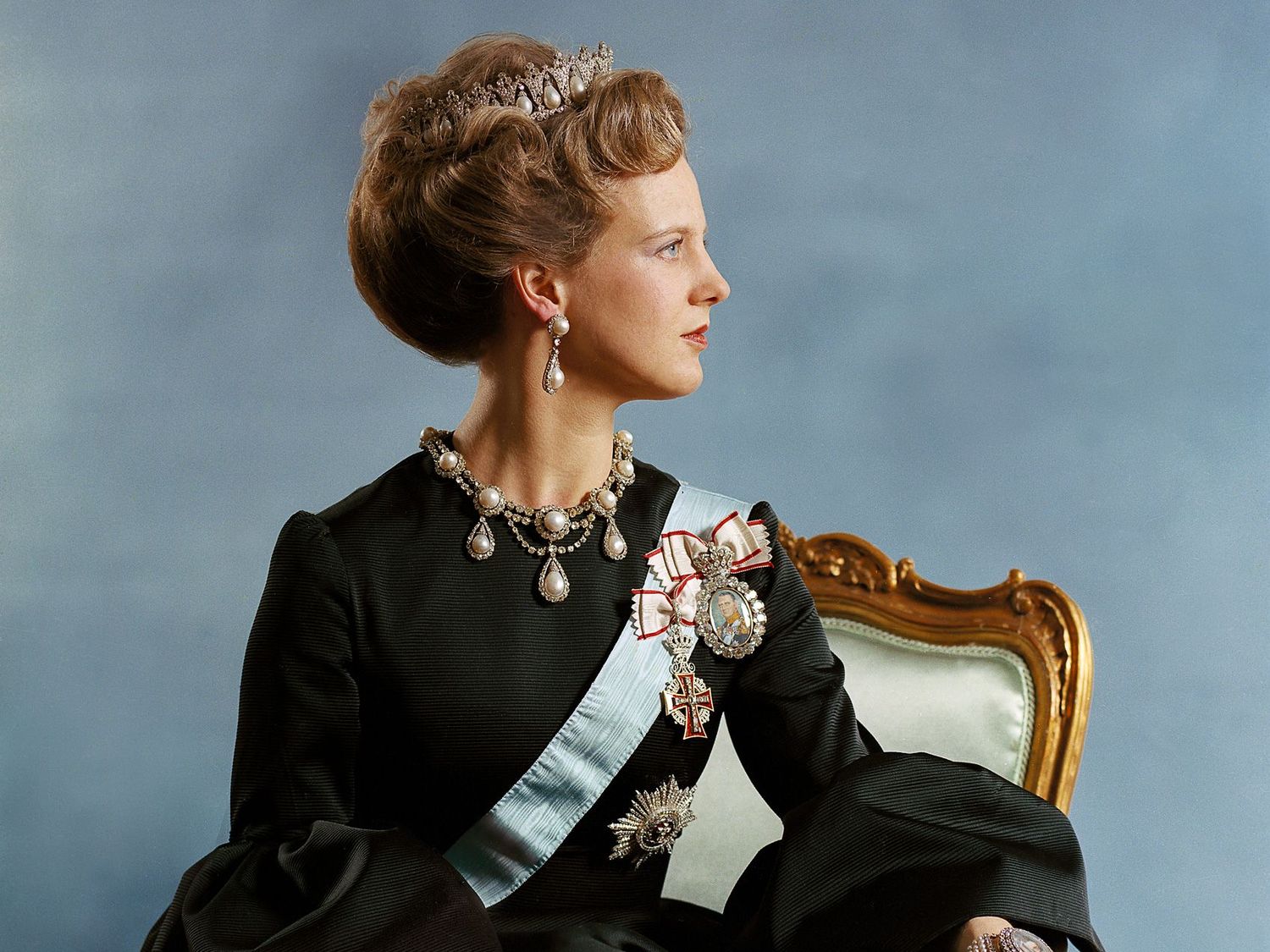
14. januar 1972
Dronning Margrethe 2. overtager tronen
Dronning Margrethe 2. overtog tronen den 14. januar 1972 efter sin far Frederik 9.'s død.
-
22. januar 1972
Jens Otto Krag underskriver Romtraktaten
Statsminister Jens Otto Krag underskriver Romtraktaten i Bruxelles 22. januar 1972, hvilket markerede Danmarks medlemskab i Det Europæiske Fællesskab.
-
1. januar 1973
Danmark bliver medlem af Det Europæiske Fællesskab (1973)
Den 1. januar 1973 blev Danmark medlem af Det Europæiske Fællesskab (EF) sammen med Irland og Storbritannien. EF var forløberen for det nuværende EU. Storbritannien forlod senere samarbejdet i 2020 (Brexit), mens Danmark og Irland fortsat er medlemmer.
-

1973
Fri adgang til abort vedtaget
I 1973 vedtog Folketinget, at danske kvinder selv skulle kunne vælge, om de ville afbryde en graviditet indtil 12. graviditetsuge. Modstanden mod den fri abort førte til dannelse af Kristeligt Folkeparti, nu kaldet Kristendemokraterne.
-
1973
Færøerne udenfor EF (EU)
Da Danmark blev medlem af EF (EU) i 1973, valgte Færøerne at stå udenfor, hvilket gav mulighed for at indgå egne handelsaftaler uden om EU. -
1973
Overgang til offentligt sygesikringssystem
I 1973 blev de tidligere sygekasser afløst af et helt igennem offentligt sundhedssystem, kendt som Den offentlige sygesikring, hvilket betød, at sundhedspleje blev fuldstændigt statsligt finansieret for alle borgere i Danmark. -
1973
Stop for indvandring i Danmark
Der blev indført stop for indvandring i Danmark i 1973, men gæstearbejdere og deres familier kunne stadig bosætte sig permanent. -
4. december 1973
Jordskredsvalget og partimangfoldighed i Folketinget
Ved det såkaldte Jordskredsvalg den 4. december 1973 skete et markant vælgerskred: Socialdemokratiet, Det Radikale Venstre, Venstre, Det Konservative Folkeparti og SF mistede mange stemmer, mens fem nye partier – heriblandt Fremskridtspartiet – kom i Folketinget. Valget ændrede den danske partistruktur grundlæggende, og siden da har der ved hvert valg typisk siddet mellem syv og tolv partier i Folketinget. Dette afspejler et valgsystem, som giver selv mindre partier gode muligheder for repræsentation, så længe de opnår mindst omkring to procent af de gyldige stemmer.
-
1974
Økonomisk krise i Danmark
I 1974 blev Danmark ligesom mange andre vestlige lande ramt af en økonomisk krise. Den blev udløst af, at priserne på olie steg voldsomt i 1973. Prisforhøjelsen skyldtes de arabiske landes forsøg på at presse de vestlige lande, som støttede Israel i Yom Kippur-krigen, gennem signifikante prisstigninger på olie. -
1976
Lov om lige løn vedtages i Danmark (1976)
I 1976 vedtog Folketinget en lov om lige løn for samme arbejde, som implementerede et EF-direktiv (i dag EU) og imødekom krav fra kvindebevægelsen om ligestilling. Loven fastslog, at mænd og kvinder skal have samme løn for lige arbejde. -
1978
Grønland og Danmark enige om hjemmestyre
Grønland og Danmark blev i 1978 enige om at etablere hjemmestyre for Grønland. -
1978-1979
SV-regeringen dannes
I 1978-79 bestod den danske regering af Socialdemokratiet og Venstre, og blev kaldt SV-regeringen. -
1978-1982
Tv-serien Matador første visning
Tv-serien Matador blev vist første gang fra 1978 til 1982. Den beskriver livet i 1930'erne og 1940'ernes Danmark i den fiktive by Korsbæk. -
1978
Valgretsalder nedsat til 18 år
Siden grundloven i 1915 er valgretsalderen til Folketinget gradvist blevet nedsat frem til den gældende valgretsalder på 18 år, som blev vedtaget i 1978. -
1979-1980
Anden oliepris-stigning
Problemerne i Danmark blev forværret og forlænget, da endnu en voldsom prisstigning på olie indtraf i 1979-80. Denne stigning var et resultat af uroligheder i Iran i forbindelse med den islamiske revolution og den efterfølgende krig mellem Iran og Irak. -
1979
Grønland fik hjemmestyre ved lov
Efter en folkeafstemning fik Grønland ved lov hjemmestyre i 1979, som indebar, at Grønland overtog ansvaret for en række områder som socialpolitik, skatter og undervisning.
1980s
-
1980
Medierne bliver 'samfundets vagthund'
Siden 1980'erne har danske aviser tydeligere påtaget sig opgaven som 'samfundets vagthund' ved at holde øje med alle former for magthavere. Det betyder, at mediehistorier kritiske over for magten ofte opfattes som gode nyhedshistorier. -
1980
Stigende ulighed efter 1980’erne
Selvom uligheden er blevet større siden 1980’erne, opretholdt Danmark i 2021 en forholdsvis stor grad af økonomisk lighed i forhold til andre lande. Skiftende regeringer har siden 1980'erne forsøgt at få befolkningen til at arbejde mere ved at reducere marginalskatten. -
1981
Grækenland blev EF-medlem
I 1981 blev Grækenland medlem af Det Europæiske Fællesskab. -
1982
Gymnasial uddannelse stiger til 36%
I 1982 tog 36 procent af en årgang en gymnasial uddannelse i Danmark. -
1982-1987
Moderne glasmosaikker i Ribe Domkirke
Carl-Henning Pedersen skabte moderne glasmosaikker og kalkmalerier til Ribe Domkirke mellem 1982 og 1987. -

1982
Poul Schlüter fra Det Konservative Folkeparti blev statsminister
I 1982 overgav Socialdemokratiet regeringsmagten til den borgerlige fløj uden folketingsvalg på grund af økonomiske udfordringer. Poul Schlüter fra Det Konservative Folkeparti blev statsminister. Denne ændring markerede starten på en periode, hvor borgerlige partier hyppigere havde regeringsmagten.
-
1982
Støtte til danske børnefilm
I 1982 gav Folketinget økonomisk støtte til danske børnefilm og anerkendte genrens kunstneriske betydning. -
1984
Premiere på Busters Verden
Bille Augusts film Busters Verden fra 1984 omhandler Buster, der bruger sin fantasi og tryllekunster til at klare sig igennem vanskeligheder. -
1985-1986
Danmark i Sikkerhedsrådet 1985-86
Danmark har været medlem af FN's Sikkerhedsråd i perioden 1985-86. -
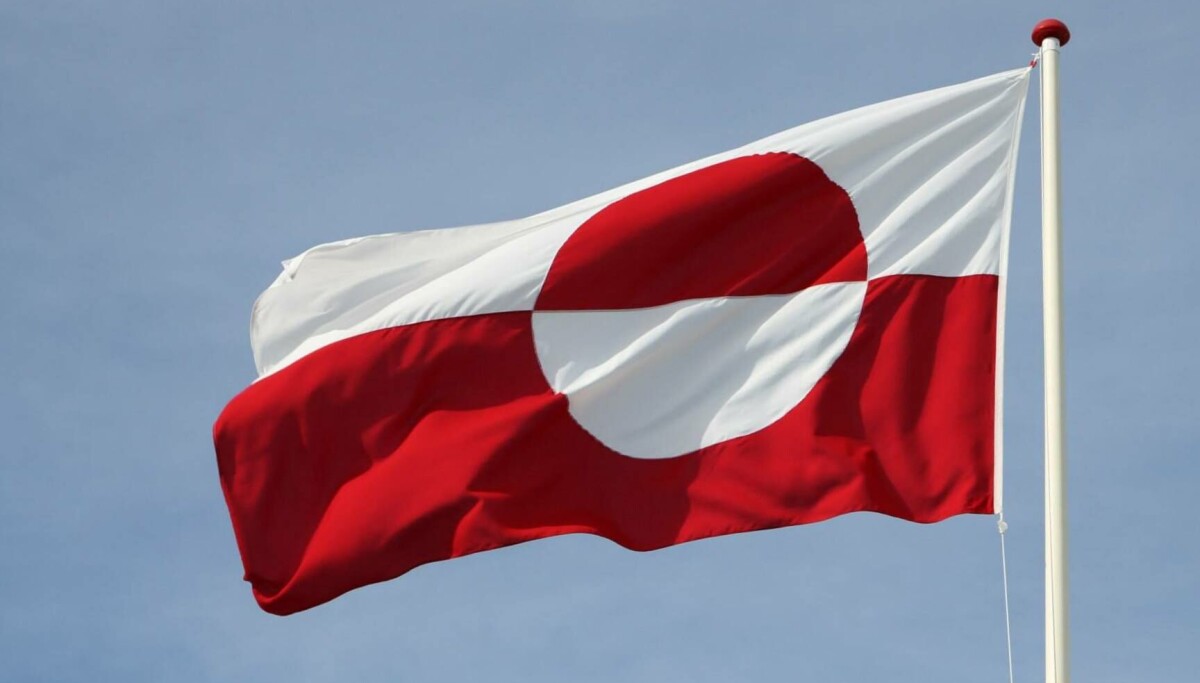
1985
Erfalasorput - Grønlands flag blev hejst
Det grønlandske flag blev hejst første gang den 21. juni 1985. På grønlandsk kaldes det ’Erfalasorput’, som betyder ’vort flag’. Flagets farver er rød og hvid som i Dannebrog, og cirklen symboliserer den opadgående sol i det hvide grønlandske landskab.
-
1985
Folketinget beslutter energiplan uden atomkraft
I 1985 besluttede Folketinget at planlægge Danmarks fremtidige energiforsyning uden atomkraft, påvirket af folkelig modstand mod atomkraft og den alvorlige ulykke på Tjernobyl-atomkraftværket i 1986. -
1985
Grønland meldte sig ud af EF
Grønland blev som en del af kongeriget Danmark medlem af EF (nu EU) i 1973, men blev efter en folkeafstemning i Grønland meldt ud igen i 1985. -
1986
DR's monopol ophæves
I 1986 ophævede Schlüter-regeringen DR's monopol på at sende dansk tv. Folketinget vedtog etableringen af TV2, som sendte første gang i 1988. Dette førte til en betydelig stigning i antallet af radio- og tv-kanaler i Danmark og større mediemangfoldighed. -
1986
Ny folkeafstemning om EF-pakken
I 1986 var der en folkeafstemning i Danmark om Den Europæiske Fællesakt, kendt som EF-pakken. Den sigtede mod at gennemføre et indre marked i EF. Et flertal af danskerne (56,2 procent) stemte ja. -
1986
Skatteøen musical blev populær
I 1986 blev musicalen 'Skatteøen', komponeret af musikeren Sebastian, en af de største hits inden for den voksende musical-genre i Danmark. -
1986
Spanien og Portugal indtrådte EF
I 1986 indtrådte Spanien og Portugal i Det Europæiske Fællesskab. -
1986
Tjernobyl-ulykken påvirker modvilje mod atomkraft
En alvorlig ulykke på atomkraftværket Tjernobyl i Sovjetunionen (nu Ukraine) i 1986 forstærkede den danske modvilje mod atomkraft. -

1987
Premiere på Pelle Erobreren
Bille Augusts film Pelle Erobreren fra 1987 vandt både en Oscar og De Gyldne Palmer og er baseret på Martin Andersen Nexøs roman.
-
1988
Gabriel Axel vinder Oscar
Gabriel Axel blev den første danske instruktør til at vinde en Oscar i 1988 for Babettes Gæstebud, baseret på Karen Blixens fortælling.
-

1989
Berlinmurens fald
Berlinmuren faldt i november 1989. Dette markerede enden på Den Kolde Krig sammen med Sovjetunionens opløsning i 1991.
-
1989
Disneys 'Den lille havfrue'
H.C. Andersens eventyr inspirerede Disneys tegnefilm 'Den lille havfrue', som blev udgivet i 1989.
-

1989
Registreret partnerskab for homoseksuelle
I 1989 blev Danmark det første land i verden, der tillod to personer af samme køn at indgå et registreret partnerskab med stort set de samme retsvirkninger som et ægteskab.
1990erne
-
1990
6.000 afslutter kandidatuddannelse
Omkring 6.000 studerende gennemførte en kandidatuddannelse i Danmark i 1990. -
1990
Danmark ind i globaliseringens æra
Siden 1990 har Danmark været præget af globalisering, faldet af Berlinmuren og Jerntæppet, samt nye konflikter og kampen mod terrorisme. -
1990
Danmarks CO2-udledning reduceret siden 1990
Danmarks udledning af drivhusgasser er siden 1990 faldet med cirka 47 procent, som en del af bestræbelserne på at reducere udslippet. -
1990
Danmarks forsvarsbudget falder
I perioden 1990-2015 faldt Danmarks forsvarsbudget fra 2,0 til 1,05 procent af BNP, hvilket er under NATO's målsætning om to procent. -
1990-1991
Iraks invasion af Kuwait og Danmarks bidrag (1990-1991)
Irak invaderede Kuwait den 2. august 1990. På baggrund af FN-resolutioner ledte USA en international koalition, der skulle befri Kuwait og håndhæve en maritim handelsblokade mod Irak. Danmark bidrog med fregatten HDMS *Olfert Fischer*, som patruljerede i Den Persiske Golf for at håndhæve blokaden. Skibet deltog ikke i egentlige kamphandlinger, men var en del af koalitionens styrke frem til befrielsen af Kuwait i februar 1991. -
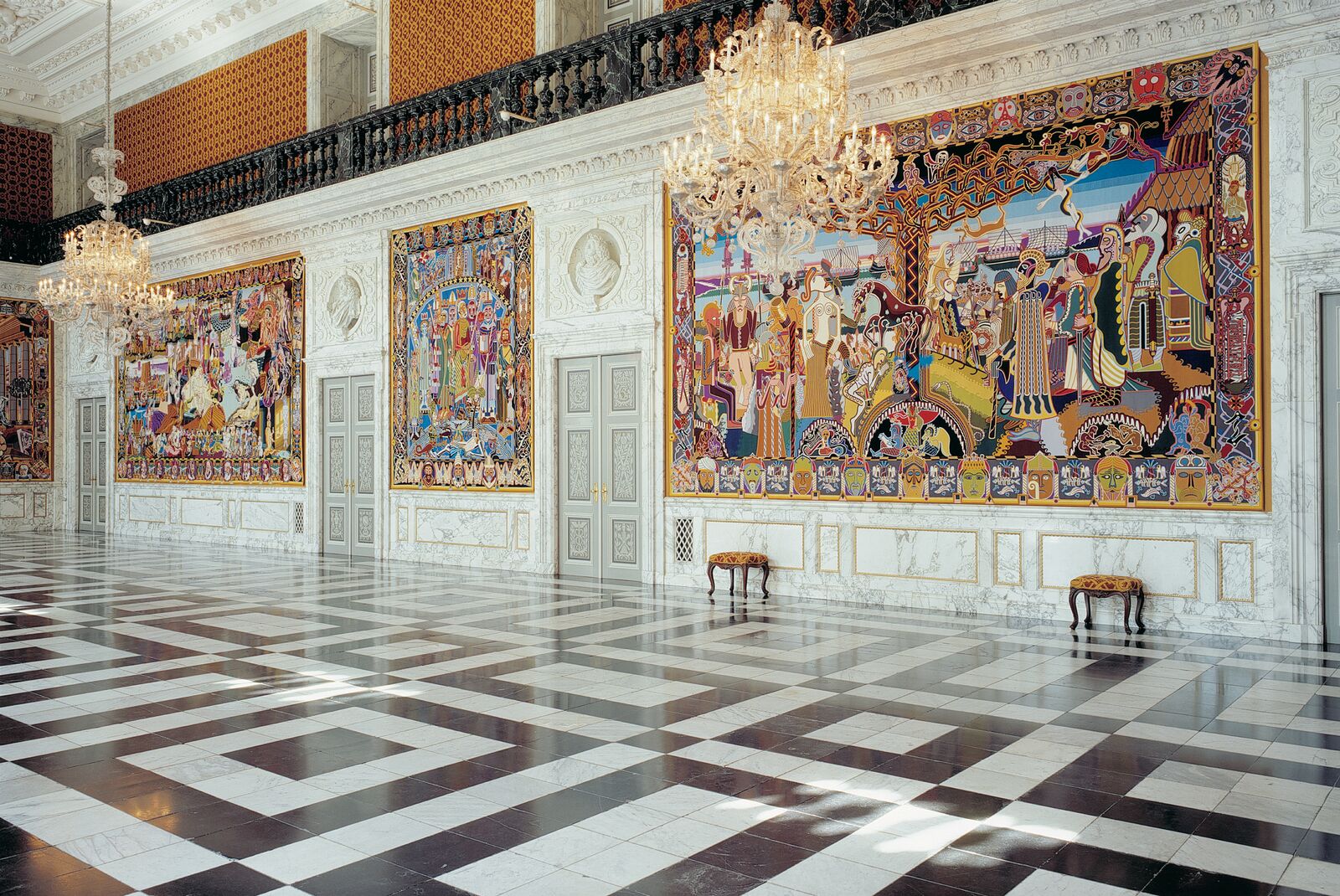
1990
Nørgaard gobeliner indviet
I 1990 blev Bjørn Nørgaard's 17 gobeliner, der dekorerer riddersalen på Christiansborg, indviet. De beskriver danmarkshistorien fra vikingetiden til 2000, og blev skabt som gave til Dronningens 50-års fødselsdag.
-

1991
Inger Christensens 'Sommerfugledalen'
Inger Christensens digt 'Sommerfugledalen' fra 1991 betragtes som et af nyere dansk litteraturs store værker.
-
1991-1992
Jugoslaviens opløsning
Jugoslavien blev opløst i 1991-92, hvilket førte til oprettelsen af flere selvstændige stater, der hurtigt kom i konflikt.
-

1991
Jugoslaviske flygtninge under borgerkrigen
Flygtninge kom til Danmark fra borgerkrigen i Jugoslavien, der varede fra 1991 til 1995.
-

1991
Sovjetunionens opløsning
Sovjetunionens opløsning i 1991 betød enden på Den Kolde Krig og førte til store forandringer i Europa.
-

1991
Verdens første havvindmøllepark
I 1991 opstillede Danmark verdens første havvindmøllepark, Vindeby, ud for Lolland, markerende en vigtig milepæl i udviklingen af vedvarende energi.
-

1992
Nej til Maastricht-traktaten
Den 2. juni 1992 stemte et flertal af danskerne nej til Maastricht-traktaten ved folkeafstemningen. Som følge heraf blev Edinburgh-aftalen indgået, som gav Danmark særlige forbehold i EU-samarbejdet – herunder om den økonomiske og monetære union, fælles forsvar, retlige og indre anliggender samt unionsborgerskab.
-
1992
Indarbejdelse af Den Europæiske Menneskerettighedskonvention i dansk lov
I 1992 blev Den Europæiske Menneskerettighedskonvention formelt integreret i dansk lovgivning på linje med andre love under grundloven. Konventionen supplerer og udbygger grundlovens friheds- og menneskerettigheder, og danske domstole kan vurdere myndighedernes overholdelse af dens bestemmelser. Samtidig fik enkeltpersoner ret til at indbringe sager mod Danmark for Den Europæiske Menneskerettighedsdomstol under visse betingelser. -
1993
EU's indre marked trådte i kraft
I 1993 trådte EU's indre marked i kraft, hvilket gjorde, at varer, tjenesteydelser, personer og kapital kunne bevæge sig mere frit mellem medlemslandene. Samme år skiftede EF navn til EU, hvilket afspejlede samarbejdets udvidelse til politiske områder. -
1993
Ja til Edinburgh-aftalen
I 1993 stemte et flertal af befolkningen ja til Edinburgh-aftalen, som gav Danmark fire forbehold overfor EU. -
1993-1994
Regering med Socialdemokratiet og tre mindre partier
I 1993-94 bestod regeringen af Socialdemokratiet og tre mindre partier. -
1993
Socialdemokratiet genvinder magten
I 1993 kom Socialdemokratiet igen til magten med Poul Nyrup Rasmussen som ny statsminister. Denne periode indledte en økonomisk opgang efter de økonomiske problemer i 1970'erne og 1980'erne. -
1993
Vedtagelse af Maastricht-traktaten med forbehold
Efter en ny folkeafstemning i 1993 stemte et flertal af danskerne ja til Maastricht-traktaten, men med fire EU-forbehold: unionsborgerskabet, den fælles valuta (euroen), forsvarsområdet og en fælles rets- og udlændingepolitik. -
1994
Danmark dømt for journalistisk ytringsfrihed
I 1994 blev Danmark dømt ved Den Europæiske Menneskerettighedsdomstol i en sag om ytringsfrihed, hvor en journalist blev straffet for at formidle racistiske ytringer i et tv-indslag. Domstolen fandt, at den danske dom var i strid med journalistens ret til ytringsfrihed. -
1994
Danske soldater i Bosnien
I forbindelse med borgerkrigen i Jugoslavien i begyndelsen af 1990’erne blev danske soldater sendt ud som en del af FN’s styrker. Her blev de involveret i direkte kamphandlinger med serbiske styrker i Bosnien i 1994. -
1994
Enhedslistens indtræden i Folketinget
Enhedslisten blev valgt ind i Folketinget for første gang i 1994, delvist grundet modstand mod EU i dele af befolkningen. -
1995
Dogme 95 manifestet
Dogme 95 manifestet blev skrevet i 1995 af instruktørerne Lars von Trier, Thomas Vinterberg, Søren Kragh-Jacobsen og Kristian Levring. Det fokuserede på enkle film med gode historier frem for tekniske effekter. -
1995
Tamilsagen mod Justitsministeren
I Tamilsagen i 1995 blev en tidligere justitsminister idømt fire måneders betinget fængsel for at have forhindret tamilske flygtninge fra Sri Lanka i at få familiesammenføring. -
1995
Østrig, Finland og Sverige blev EU-medlemmer
Østrig, Finland og Sverige indtrådte som medlemmer i Den Europæiske Union i 1995. -
1996
Oprettelse af Arktisk Råd
Arktisk Råd blev oprettet i 1996 for at styrke samarbejdet om bæredygtig udvikling i de arktiske områder inden for miljø, klima, sundhed og søfart. Rådet inkluderer lande med arktiske territorier som USA, Canada og Rusland samt de fem nordiske lande. Grønland og Færøerne spiller en stærk selvstændig rolle i rådet. -
1997
Indvielse af Storebæltsforbindelsen
Storebæltsforbindelsen mellem Fyn og Sjælland blev indviet for jernbanetrafik i 1997. -
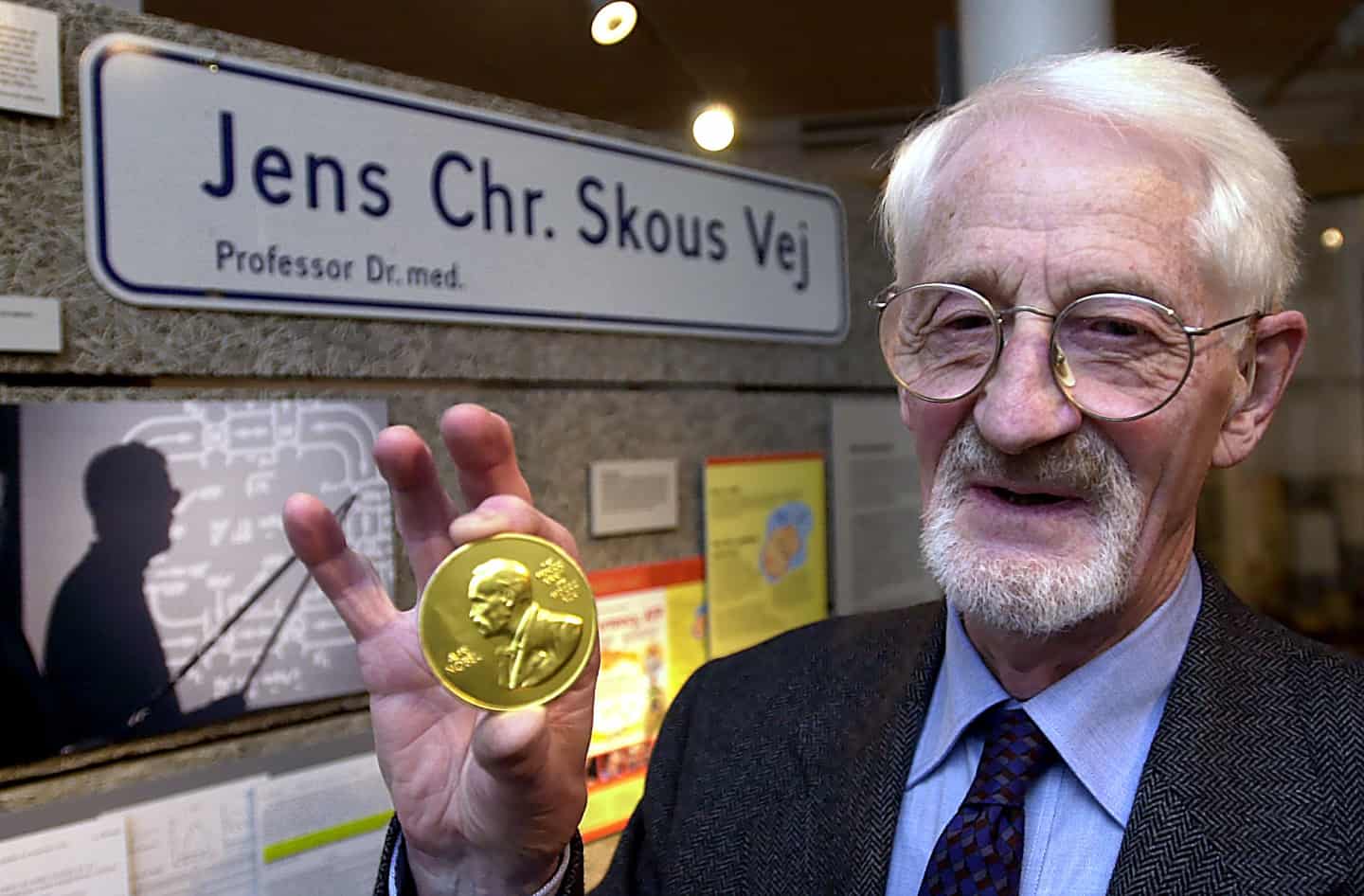
1997
Jens Christian Skou modtager Nobelprisen i kemi
Den danske læge Jens Christian Skou modtog Nobelprisen i kemi i 1997 for sin opdagelse af natrium-kaliumpumpen, som regulerer transporten af natrium og kalium i celler. Fejl i denne pumpe kan føre til hjerte- og nervesygdomme.
-
1998
Dansk Folkeparti ind i Folketinget
Dansk Folkeparti blev valgt ind i Folketinget for første gang i 1998 med Pia Kjærsgaard som partistifter og formand. Partiet satte fokus på udlændingepolitikken som et vigtigt tema ved folketingsvalg. -
1998
Premiere på Festen
Thomas Vinterbergs film Festen fra 1998 vandt Prix du Jury på Cannes Film Festival. Filmen var en del af Dogme 95 og skildrer et afslørende familiedrama. -
1998
Storebæltsforbindelse åben for biler
Storebæltsforbindelsen mellem Fyn og Sjælland blev i 1998 åbnet for biltrafik. -
1998
Storkonflikt på arbejdsmarkedet
I 1998 var der en storkonflikt på det private arbejdsmarked i Danmark, som blandt andet resulterede i, at busser ikke kørte og butikker ikke fik leveret varer. Regeringen og Folketinget greb ind med lovgivning baseret på et mæglingsforslag for at afslutte konflikten. -
1999
Amsterdam-traktaten trådte i kraft
Med Amsterdam-traktatens ikrafttræden i 1999 blev Danmarks forbehold over for unionsborgerskabet irrelevant, da det kom til at gælde for alle medlemslande. -
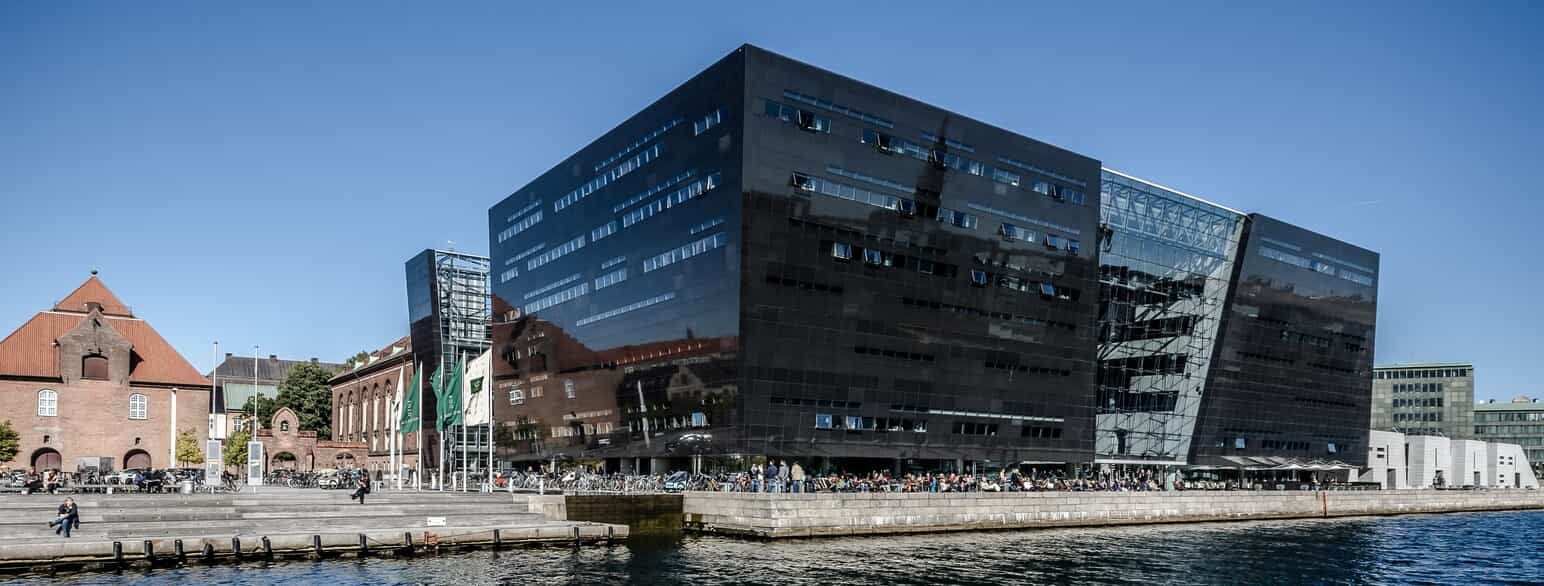
1999
Den Sorte Diamant åbner
Den Sorte Diamant, en udvidelse af Det Kongelige Bibliotek i København, blev færdiggjort i 1999. Bygningen er tegnet af Schmidt Hammer Lassen og har en stor loftudsmykning af Per Kirkeby.
-
1999
Konflikt i Kosovo
I 1999 blev Kosovo, en tidligere jugoslavisk provins, ramt af konflikt, og danske jagerfly deltog i NATO’s aktioner. -

1999
Lene Vestergaard Hau nedsætter lysets hastighed
I 1999 blev Lene Vestergaard Hau, professor ved Harvard University, internationalt kendt for sin demonstration af, hvordan man kan nedsætte lysets udbredelseshastighed i en ultrakold gas.
-
1999
NATO’s intervention i Kosovo
Også i Kosovo, som dengang var en provins i Serbien, var der borgerkrig i slutningen af 1990’erne. Her blev det albanske befolkningsflertal udsat for overgreb fra den serbiske regering. Efter lange forhandlinger uden resultat greb NATO militært ind i 1999. Her deltog danske kampfly i NATO’s aktioner. -
1999
Østeuropæiske lande optages i NATO
Siden 1999 er de fleste af Ruslands nabolande i Central- og Østeuropa, der var allierede med Sovjetunionen under Den Kolde Krig, blevet medlemmer af NATO, inklusiv Estland, Letland og Litauen fra det tidligere Sovjetunionen.



